Knowledge base
1000 FAQs, 500 tutorials and explanatory videos. Here, there are only solutions!
This guide shows you how to use the Newsletter tool provided by Infomaniak to create and send newsletters, i.e., recurring messages to multiple recipients.
Why use Newsletter instead of a Mail Service
A newsletter is a periodic communication tool sent by email to a specific group of subscribers. It generally aims to inform, share news, updates, or relevant content on a specific topic, and maintain a relationship with a targeted audience.
They can contain articles, announcements, promotions, links to recent content, upcoming events, and sometimes exclusive offers for subscribers. The main goal is to provide interesting and relevant content to engage and maintain the interest of subscribers.
Newsletter Infomaniak allows you to schedule and send newsletters to a list of email recipients who are waiting for your emails; you thus effectively and personally distribute email marketing campaigns and maintain regular and relevant communication with your customers and subscribers.
The features include creating templates, managing the subscriber list, analyzing performance, and none of this is directly possible with a traditional Mail Service. Moreover, the tool has its own interface, autonomous within your browser, completely separate from Mail Infomaniak and does not require a messaging application. This means that if you already have contacts to whom you wish to write with their consent, you will need to import them into the tool first.
Prerequisites
- Have a domain name on which you will activate the Newsletter:
- Access to your DNS zone if the domain name is not with Infomaniak.
- Create a new domain name if necessary.
- Have Newsletter credits to allow sending (1 credit = 1 newsletter sent to 1 subscriber).
You must have the explicit consent of your recipients via the double opt-in model. Sending spam and using purchased/rented address lists is prohibited. The owners of the domain name used to send newsletters are legally responsible, and violation of the general terms may result in account suspension.
Activate the Newsletter tool
To activate the Newsletter tool for the first time:
- Click here to access the management of your product on the Infomaniak Manager (need help?).
- Click on START FOR FREE to subscribe to the Newsletter offer.
- Enter the domain name that will be used (and that must belong to you - read the prerequisites above).
- Click the blue button to Approve.
- Start using the tool - or refer to this other guide if you encounter any issues or if additional configuration is requested on the screen.
Access the Newsletter tool
To access the Newsletter once activated:
- Click here to access the management of your product on the Infomaniak Manager (need help?).
- Click on the domain name concerned in the table that appears:
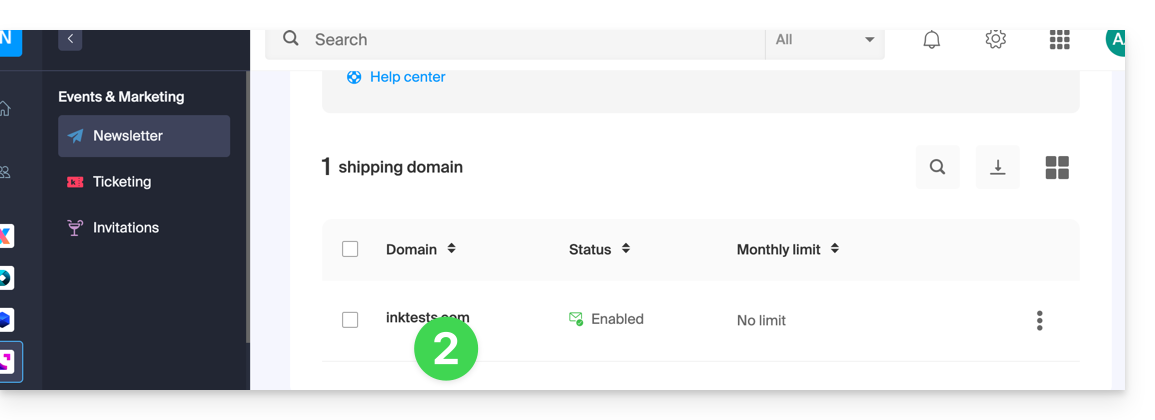
Go further with the tool
- Import contacts
- Create and send a newsletter
- Newsletter credits
- Newsletter subscription form
- Double opt-in to avoid being marked as a spammer
- Resend a newsletter to specific types of subscribers
- Variables to personalize your content
- Use the Newsletter API
See all Newsletter FAQs ; click here to share feedback or a suggestion on an Infomaniak product.
This guide explains how to transfer an Infomaniak product from one Organization to another.
Preamble
- You can move almost all products subscribed with Infomaniak to a different Infomaniak Manager interface than the one on which the product is currently located; this is therefore an internal transfer.
- If your user has access to multiple Organizations it is even easier to send to one of them the product of your choice.
- This operation does not cause any interruption.
- The users currently having access to the selected products will not be transferred (and therefore may no longer have access to the products).
- The invoices of the selected products will not be transferred.
- my kSuite cannot be transferred.
Generate a transfer link
Prerequisites
- Be Administrator or Legal Representative within the Organization.
To transfer a product:
- Click here to access the product transfer management on the Infomaniak Manager (need help?).
- Click on the Transfer products button:
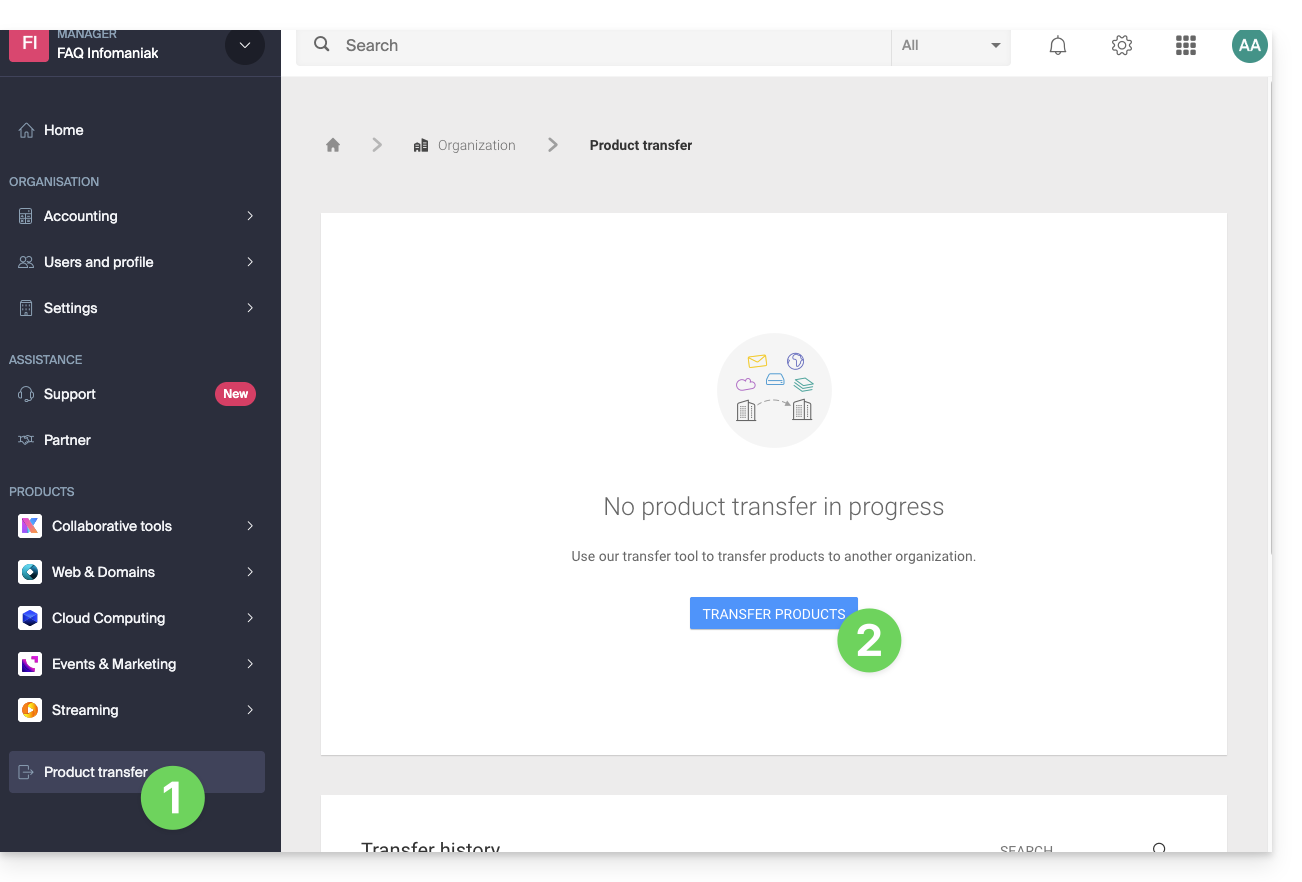
- Check the product(s) to be moved:
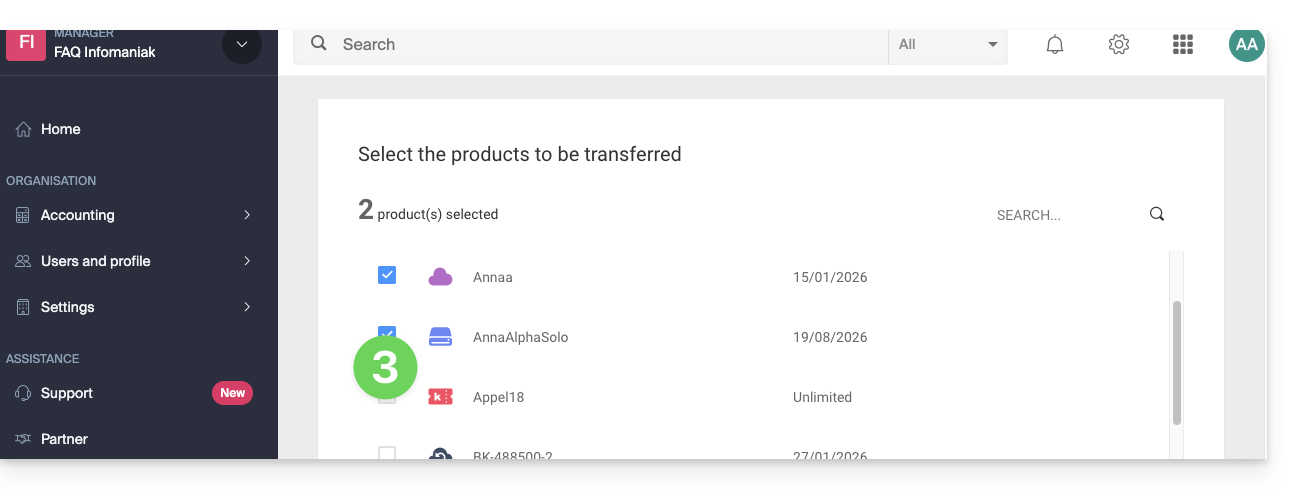
- Read and accept the general conditions.
- Click on the Transfer button:

- Read and validate any warnings:
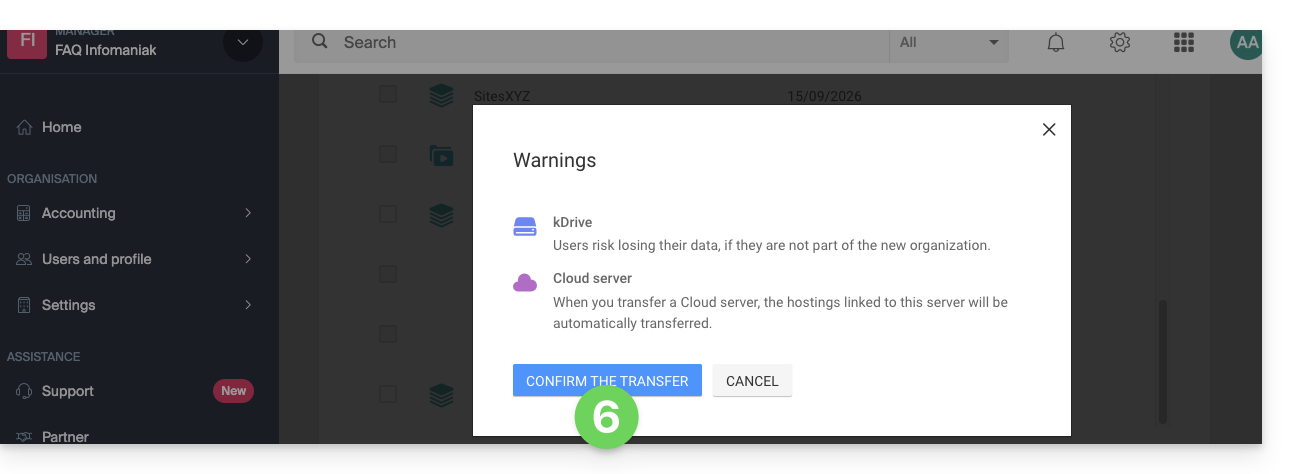
The transfer has started. Now, at your choice, you can:
- Copy the transfer link…
- or send it to the email address of your choice…
- or select directly one of the Organizations to which your user is attached, and the selected product will be transferred there:

At any time, you can return to the product transfer page to find the possibilities listed above:
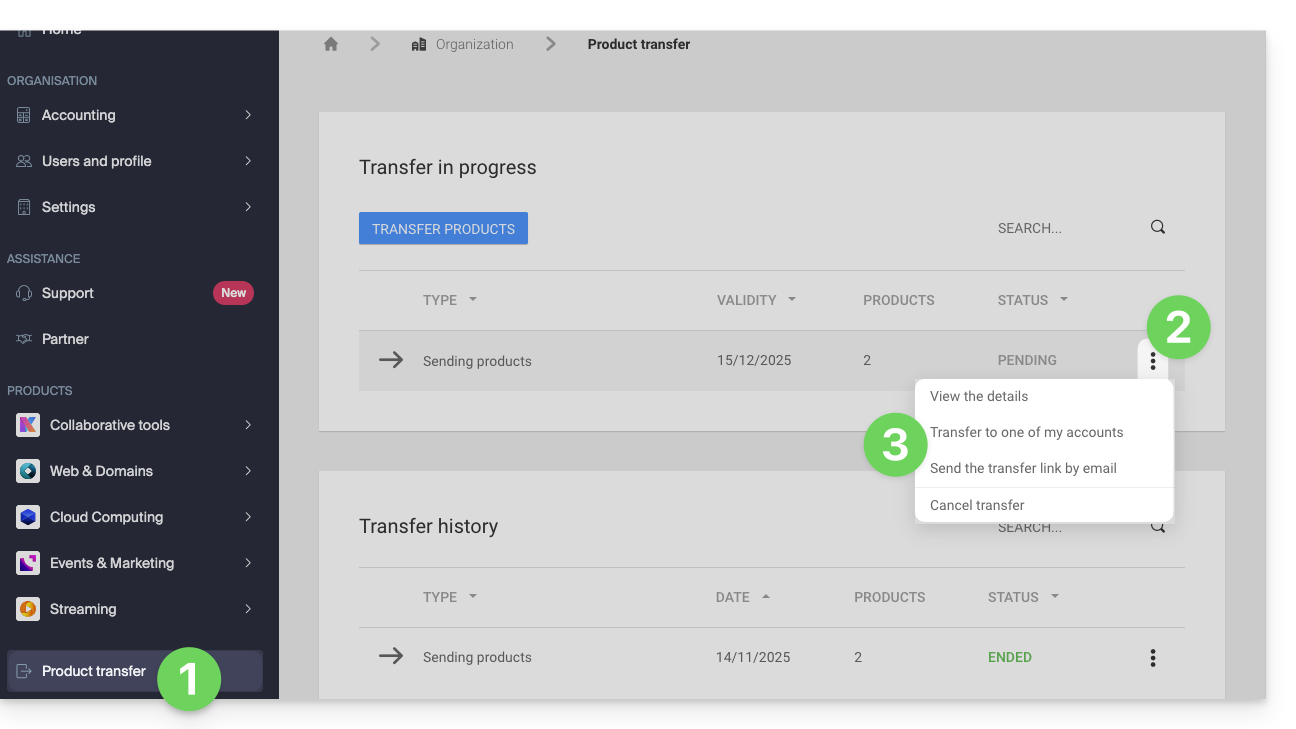
Alternative method
In the case of one-time transfer, you can also go directly to the dashboard of the product concerned and click on Manage (example in the image below) however, since this menu is not always present, it is better to prioritize the first method above, which also allows bulk transfer: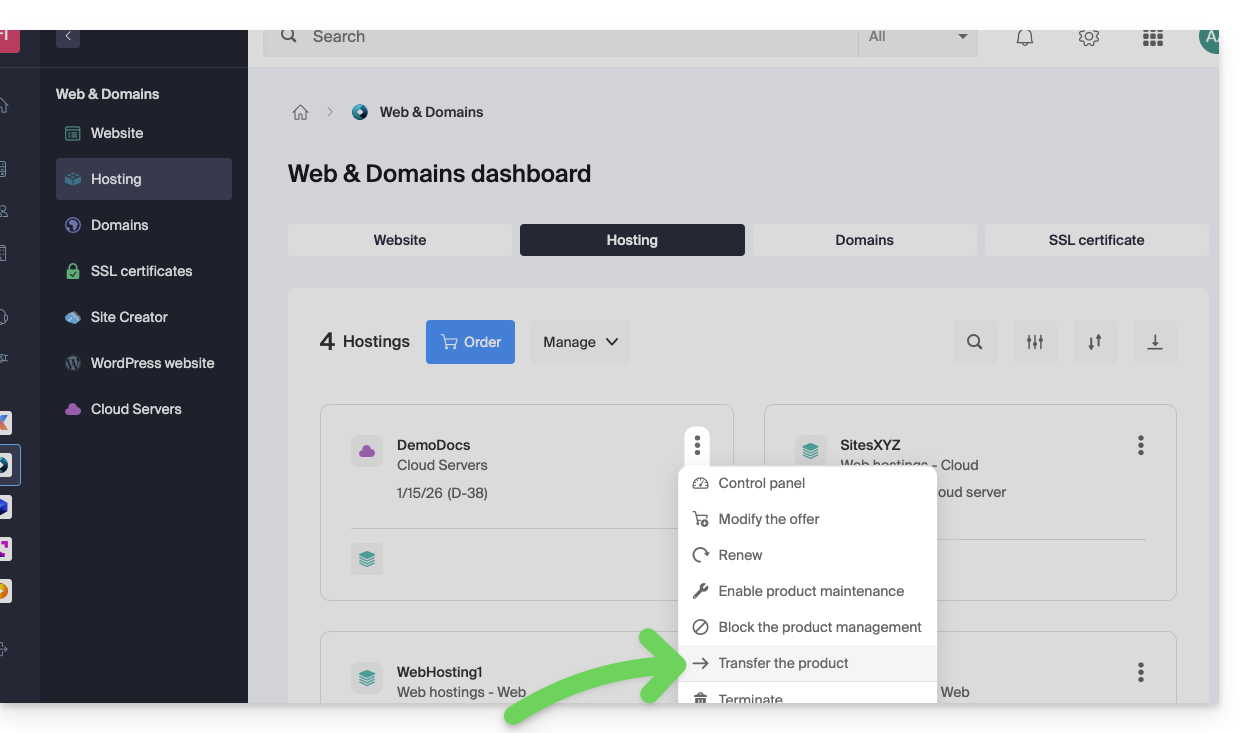
Refer to this other guide regarding Jelastic Cloud.
Receive the product
Once a product transfer is initiated by a user…
1. Be on the Organization that should receive the product
- Click here to log in to the Manager on the Organization that should receive the product(s).
- The user specified when logging in to the Infomaniak account must have administrative rights.
- If necessary, you can create a new Organization to receive products.
2. Execute the obtained link
- Click on the link obtained in the first step above.
- You can also simply paste it into a browser while logged in to the appropriate Infomaniak account.
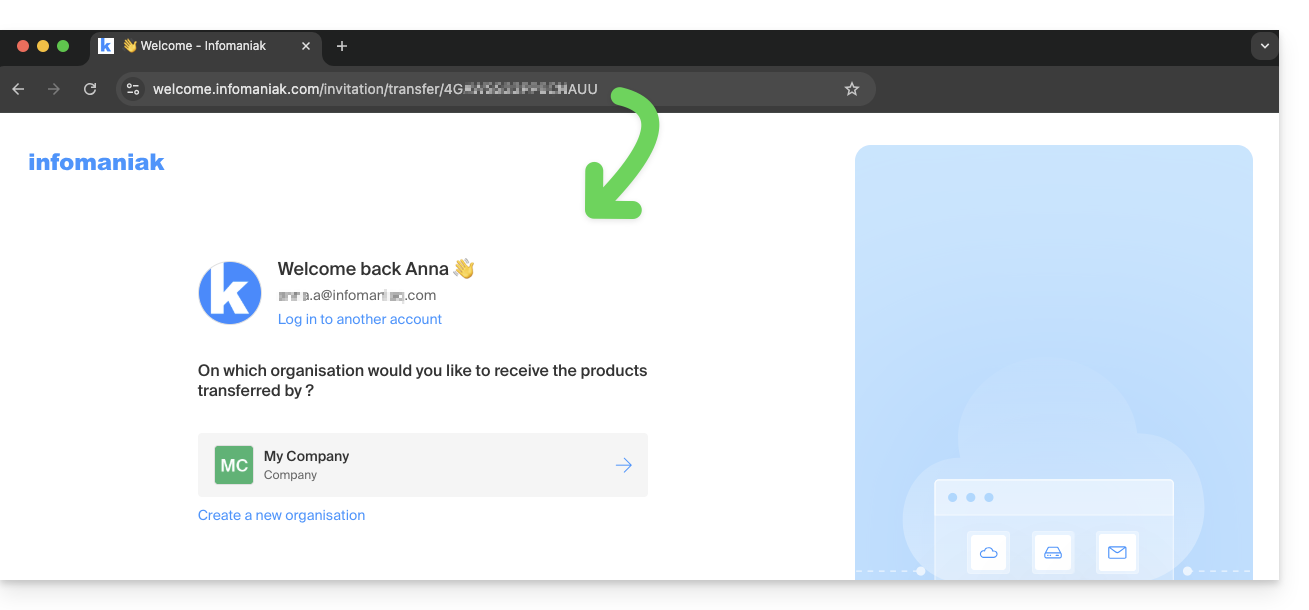
3. Validate the product transfer
- If necessary, choose the destination Organization using the drop-down menu.
- Read and accept the general conditions.
- Click the Receive the product button (if the button is not clickable, make sure you have selected the Organization).
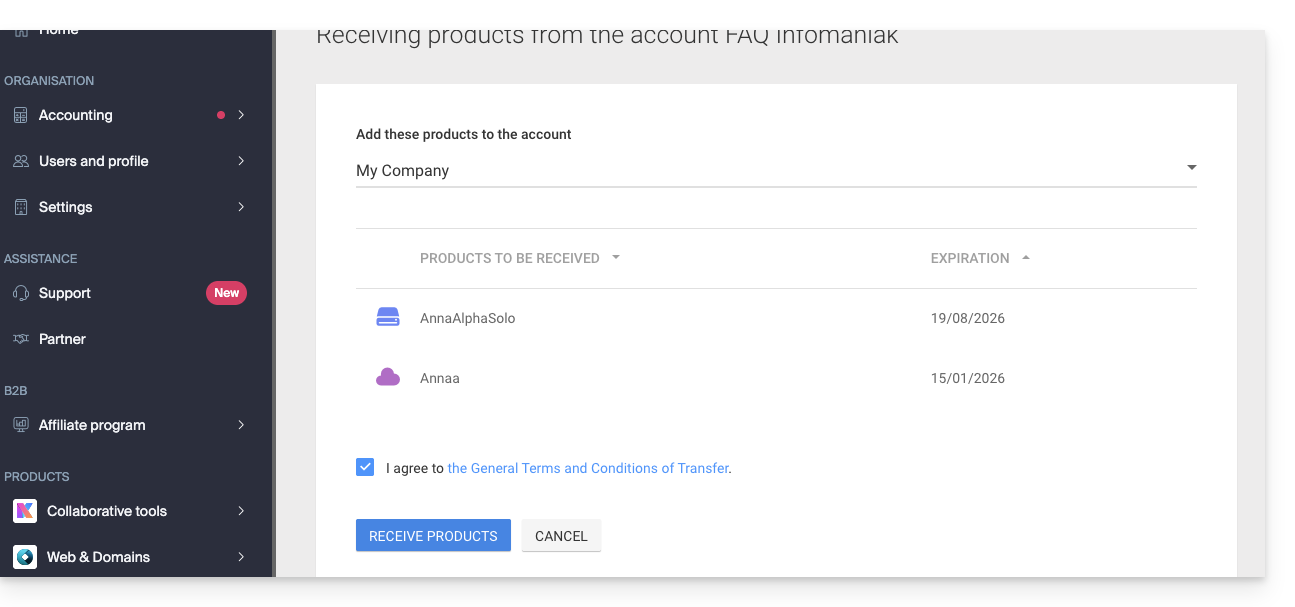
Find the ongoing or completed transfers at any time from the bottom icon on the left sidebar of the Infomaniak Manager: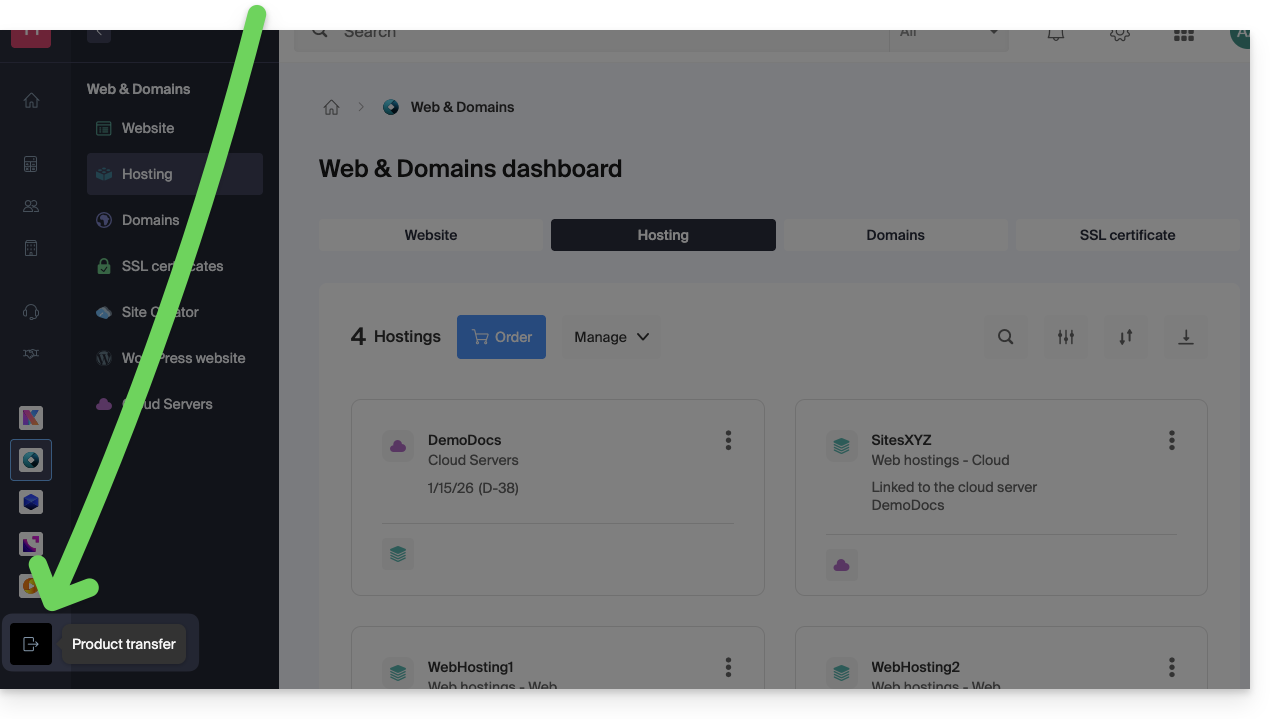
This guide covers the use of the Newsletter tool offered by Infomaniak and details the various possibilities for creating and writing targeted mailings to subscribers listed in the contact lists within the tool.
Create and send a newsletter
Your newsletters are managed from the left sidebar titled "Campaigns", which allows you to view your previous sends and create others:
- Click here to access the management of your product on the Infomaniak Manager (need help?).
- Click on the domain name concerned in the table that appears:

- Click on Campaigns in the left sidebar.
- Click on Create a campaign:
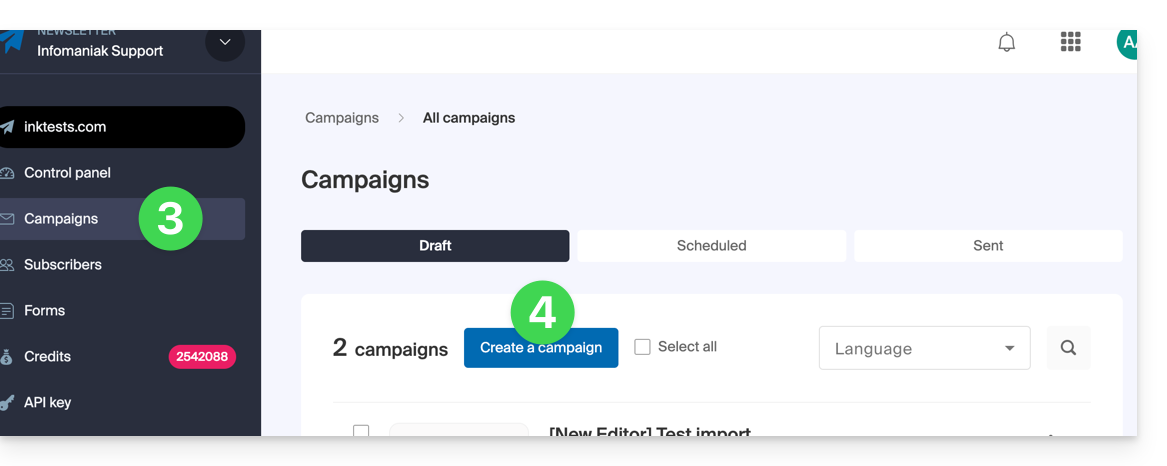
1. Details: configure the shipment
To start writing your Newsletter, complete the required information:
- Enter a subject for the email (visible to the recipient and in the list of your sends).
- Insert an emoticon if necessary.
- Insert variables (custom fields) if necessary.
- It's exactly the same principle for the preview message (which you can preview with the rest on the right side of the window).
- Enter a name corresponding to the sender (visible to the recipient).
- Enter the email address of the sender (from those existing at the domain level corresponding to the Newsletter; the email address must exist and be valid).
- Choose the language (for the language used in the additional sends such as the unsubscription one).
- Enable or disable the tracking.
- Enable or disable the UTM part.
- Click on Continue to proceed to the next step (your Newsletter is now saved in draft mode):
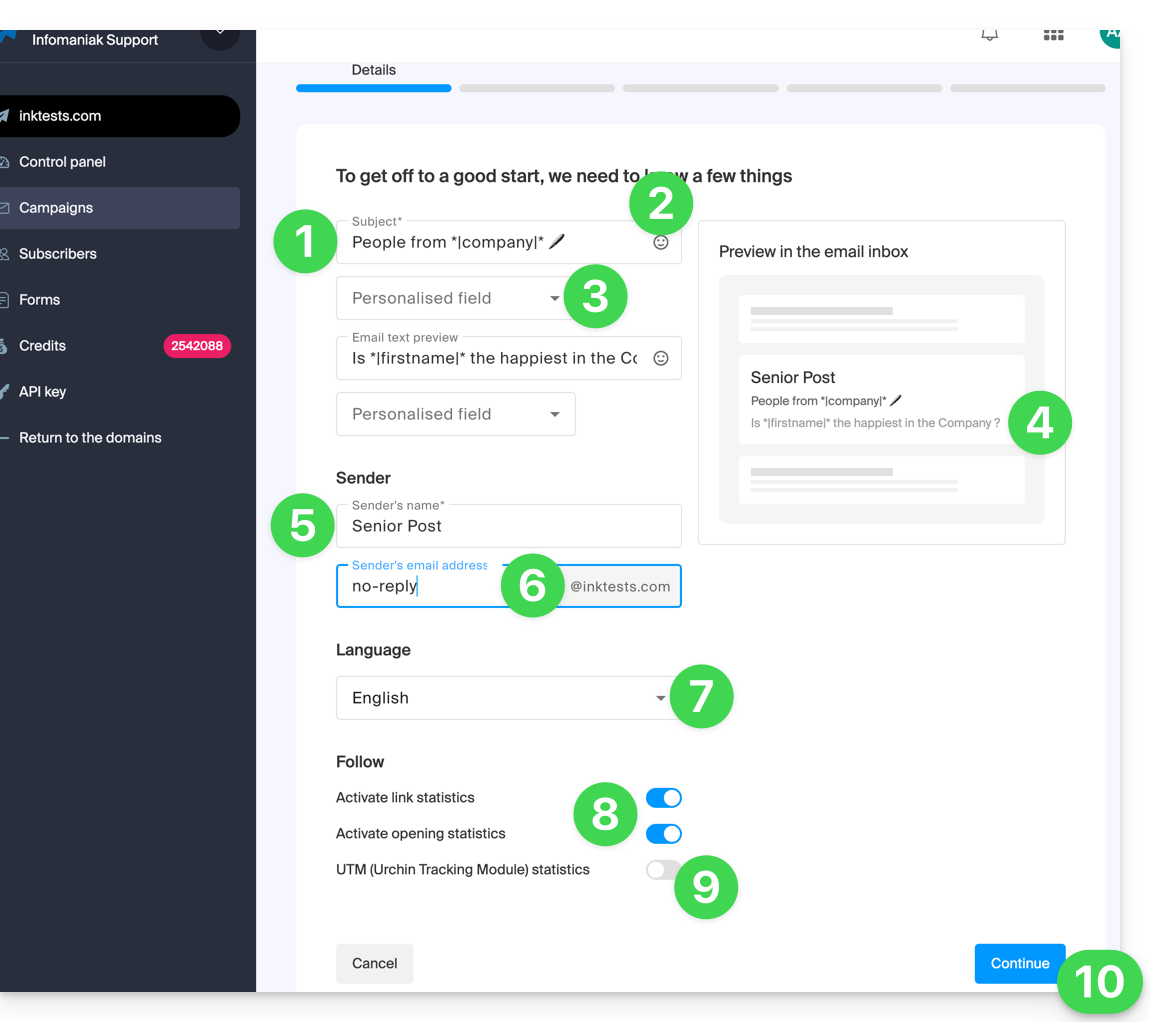
2. Choose the Newsletter theme
- If you have previously saved writing templates (blocks and designs configured to your liking), you can find them under the “My Templates” tab to reuse them.
- Otherwise, click on the Templates tab.
- Hover over a pre-configured design to start editing from this template or preview it.
- Click on the blank template to start a completely new creation from the block editor:
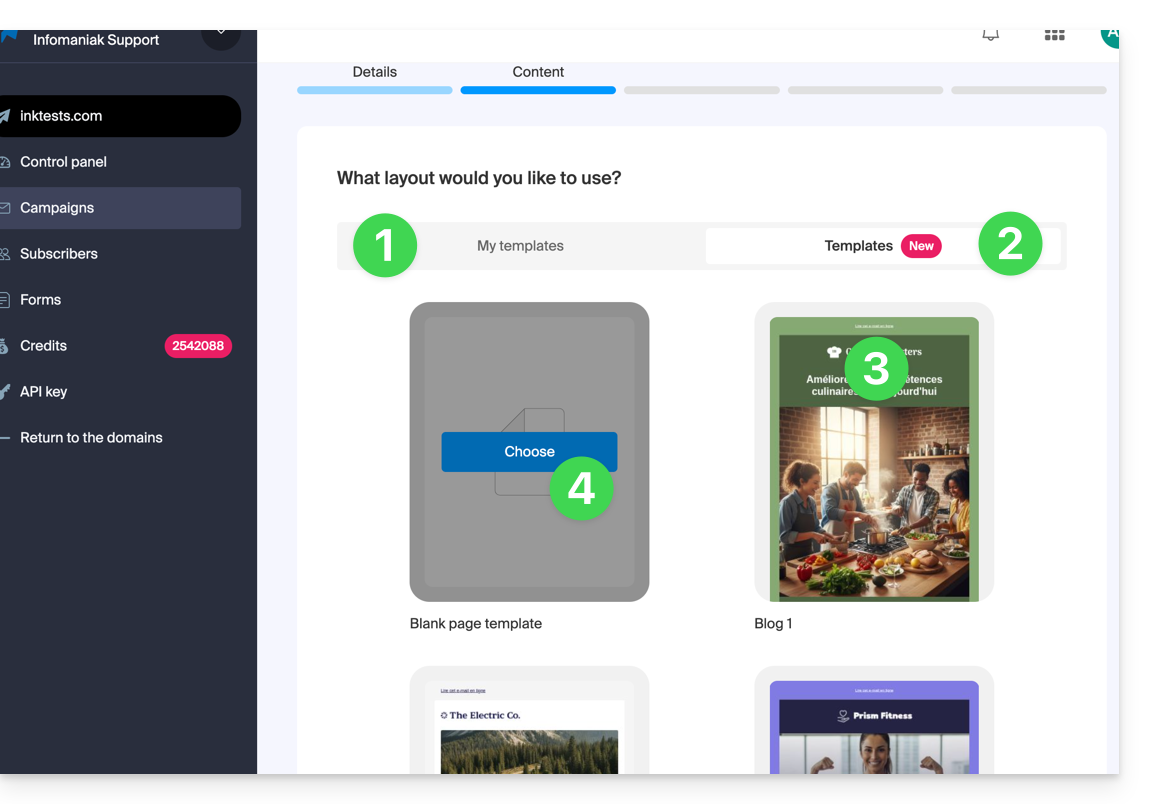
3. Write and edit the content
- At any time, your changes are saved and can be undone; you can also preview the rendering (desktop / mobile) of your Newsletter (and send a test).
- The Sections tab groups different pre-built elements, such as blocks intended for the upper part (header) or lower part (footer), etc.
- Click on the chevron to expand the content and select an element:
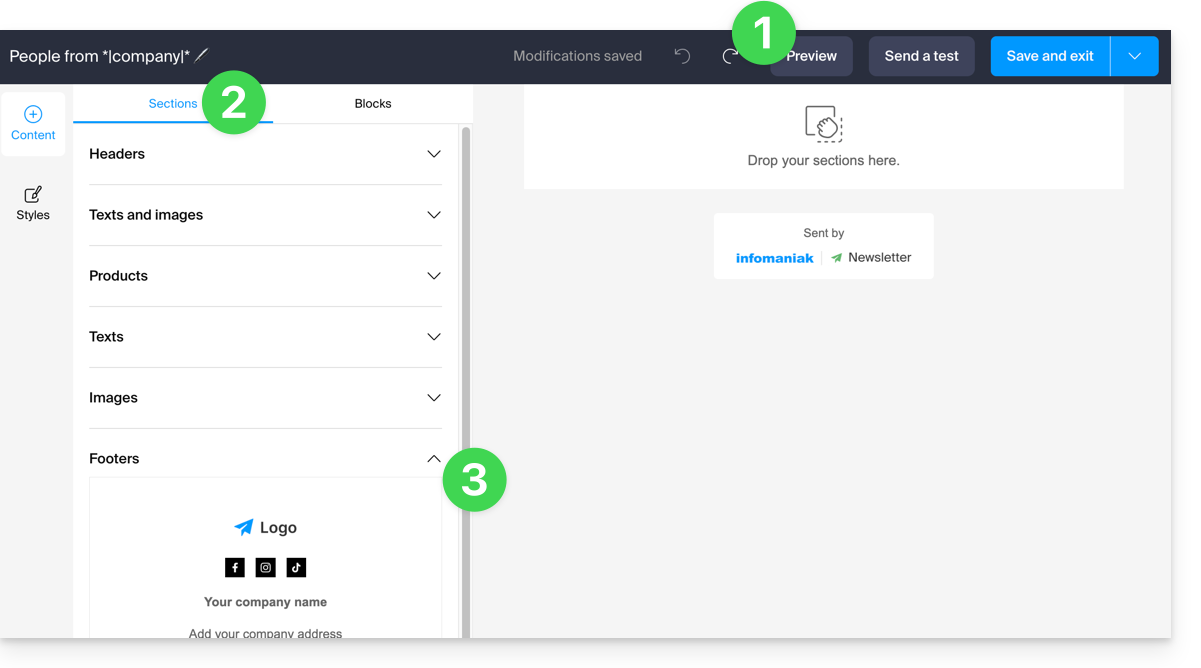
- Click on the Blocks tab to get simpler elements that you can use to compose your layout.
- Drag the selected elements into the right-hand side part to the desired location:
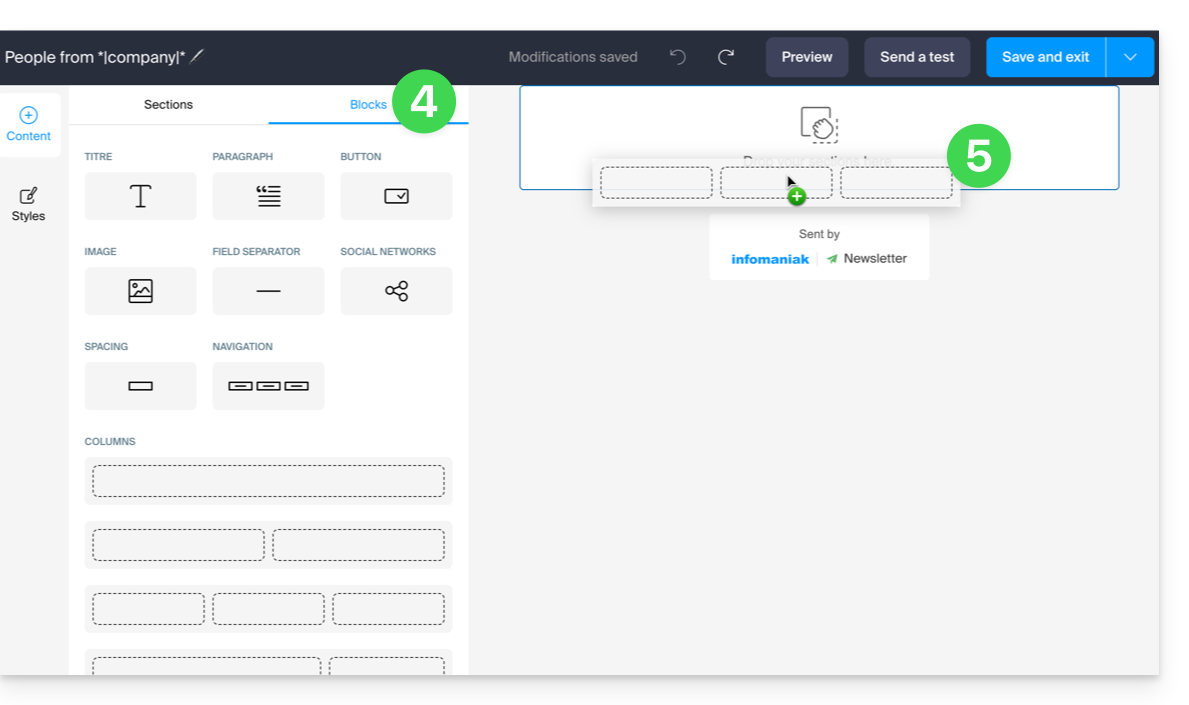
- Each element can still be adjusted when you click on it:
- The text can be formatted using the toolbar that appears above (variables can also be inserted).
- The more global editing of the element will always be found in the left-hand side panel (background color, file selection (5 MB max.) for image blocks, etc.)
- The block itself can be moved on the page, duplicated, or deleted:
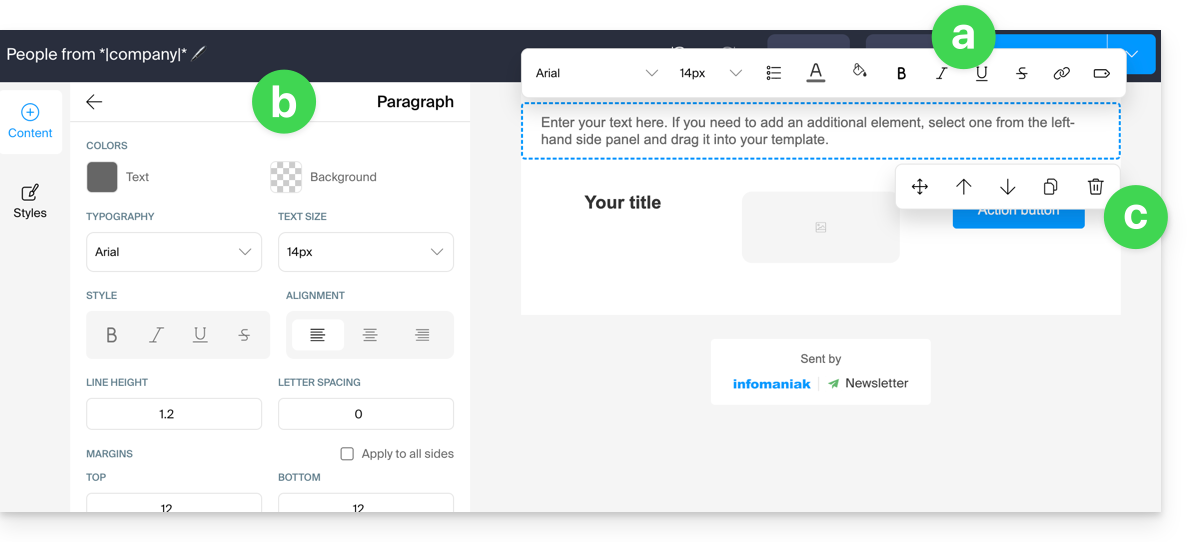
- Click on Styles to manage the characteristics that make up your different elements.
- Choose the elements to customize.
- For example, add a border to the button style.
- All new insertions of buttons and all existing buttons without customization will be affected by the modification:
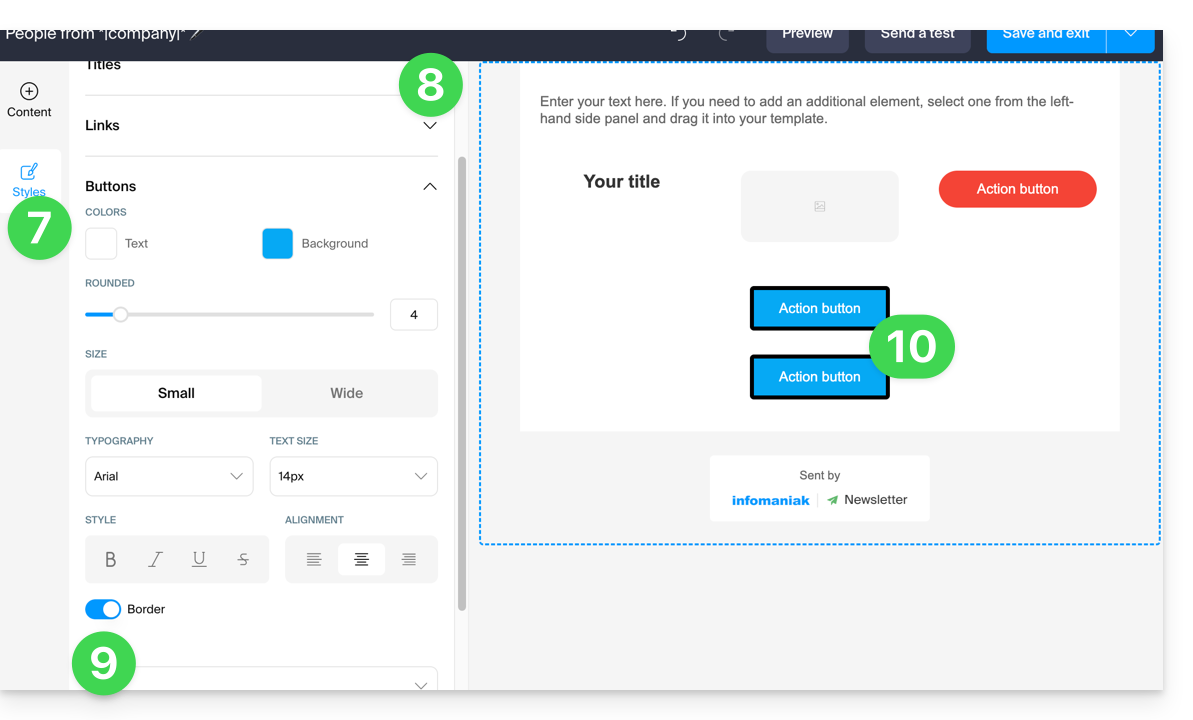
- At any time, it is possible to assign the style that has been decided for the different elements (point 8 above) by applying the default style to the elements that have been customized before:
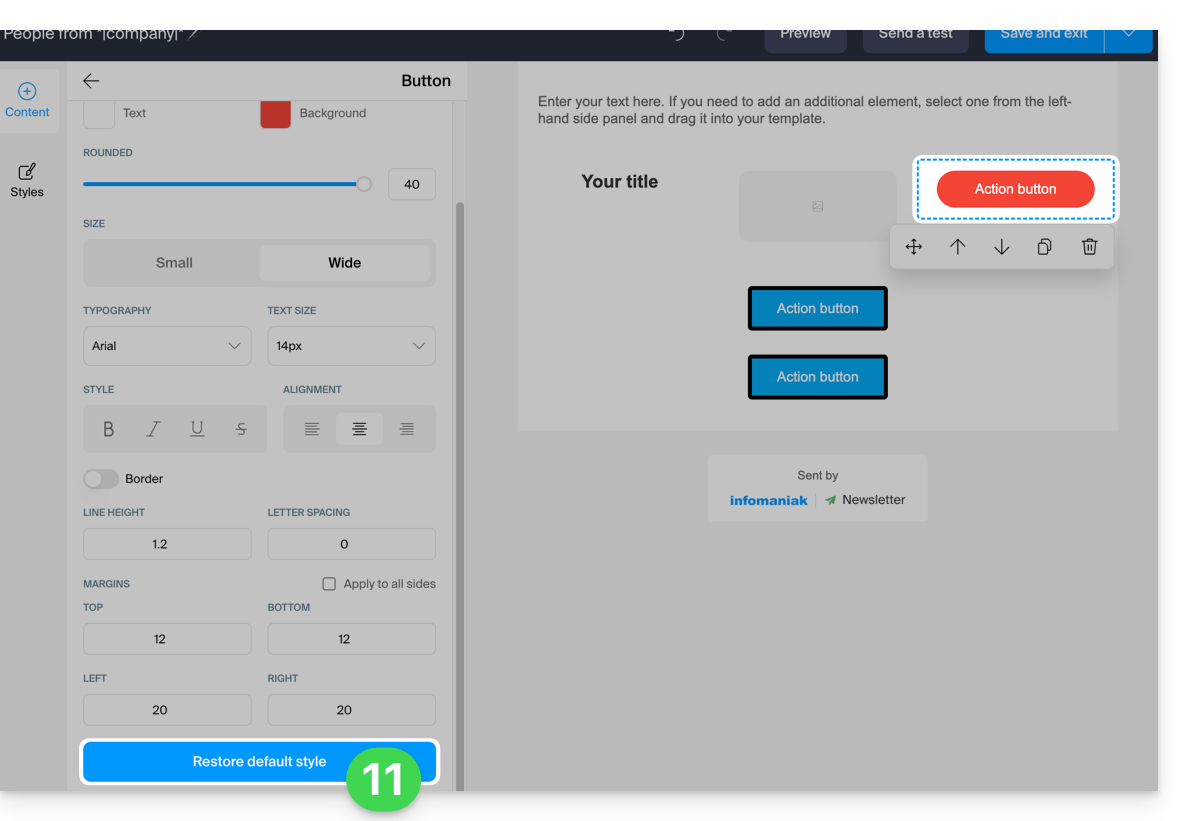
- When saving, if the mandatory information regarding the user's unsubscription is missing, it will be added to your content:
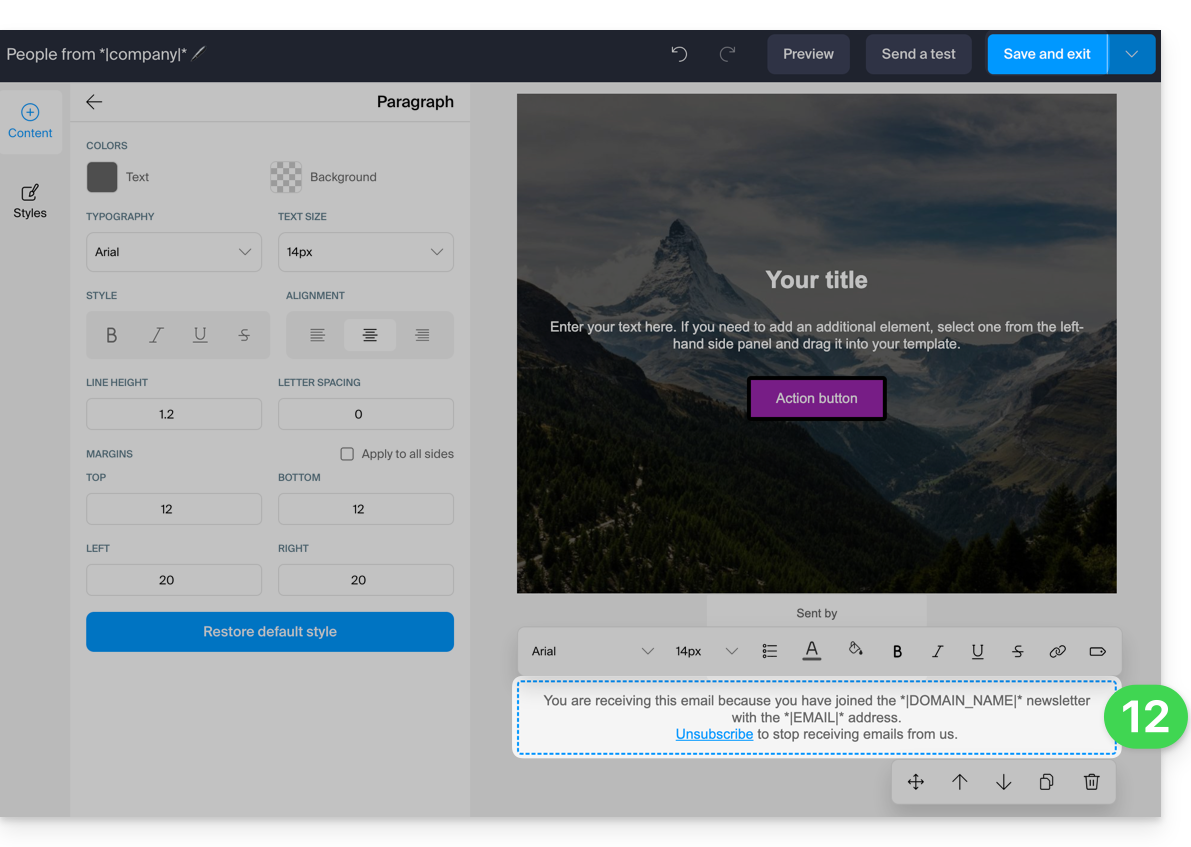
- You can save your template to reuse it for other Newsletter drafts (the template will be visible under the dedicated tab, see point 2.1 above) by clicking on the chevron to the right of the save button:

- Click on the save button at the top right when you have finished drafting your Newsletter.
4. Choosing recipients
To select your subscribers (simple mode):
- Select all subscribers by checking the box.
- The total number of subscribers represented by this item is displayed on the right, the same applies to the elements detailed below.
- You can subtract from the total number of recipients automatically selected subscribers based on criteria that you have pre-established at the segmentation level; you could also select only this segmentation.
- You can subtract from the total number of recipients grouped subscribers; you could also select only this group.
- The total number of subscribers to whom the Newsletter will be sent is automatically updated based on your choices:
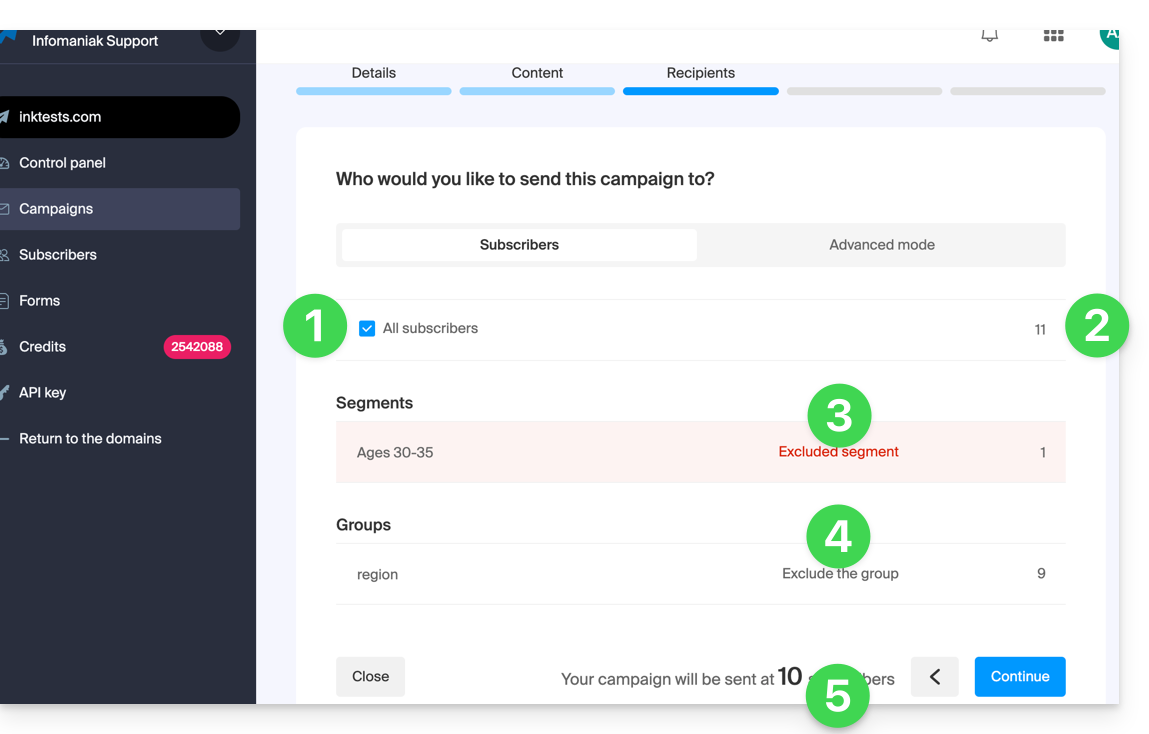
To select recipients based on certain criteria (refer to this other guide):
- Click on the Advanced tab:
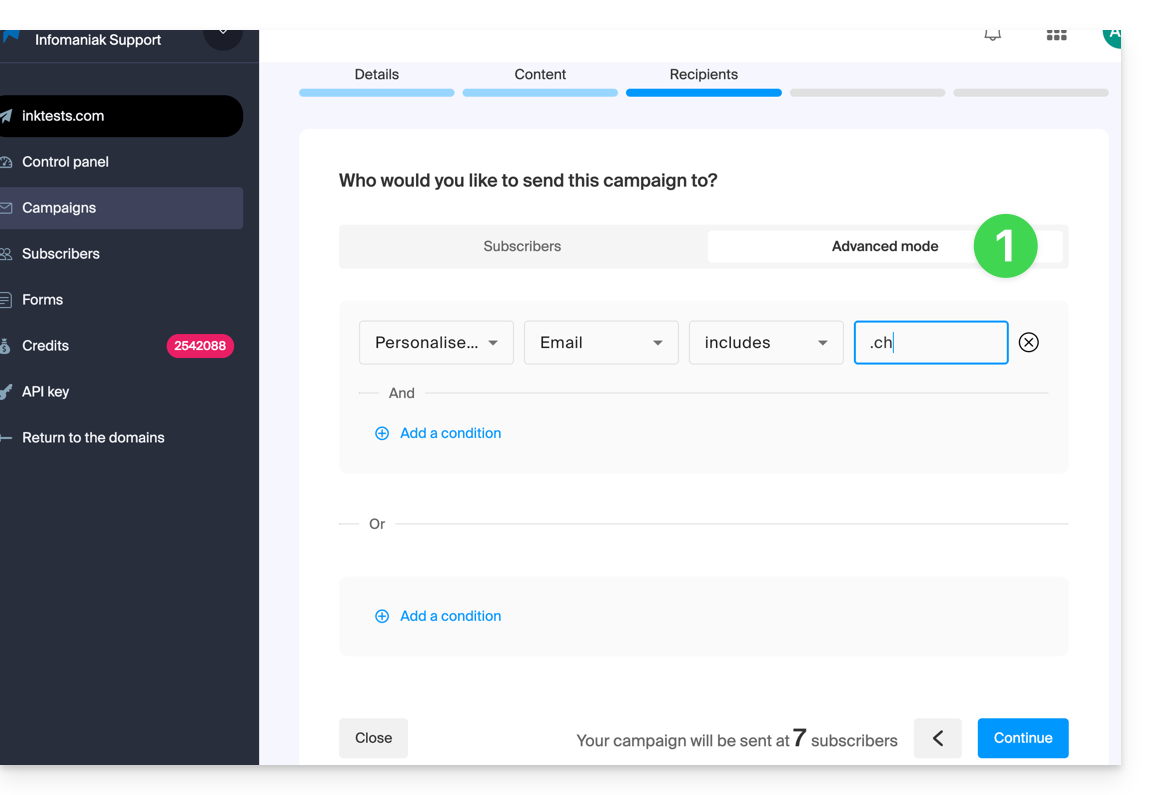
This allows you to add criteria (be careful if you add several, the additional condition can be with “AND” but also with “OR” which can include or exclude a large number of subscribers depending on your criteria).
As with the previous tab, the total number of recipients is updated at the bottom of the page dynamically based on your choices.
5. Preview and test the send
This penultimate step is summarizing: it allows you to verify the main characteristics of your send and modify any information at the last minute.
When you are ready, click on the blue button at the bottom right to proceed to the final step.
6. Trigger an immediate or delayed send
The final step allows you to choose when to send your Newsletter:
- The send can be scheduled for the desired time, or triggered immediately:
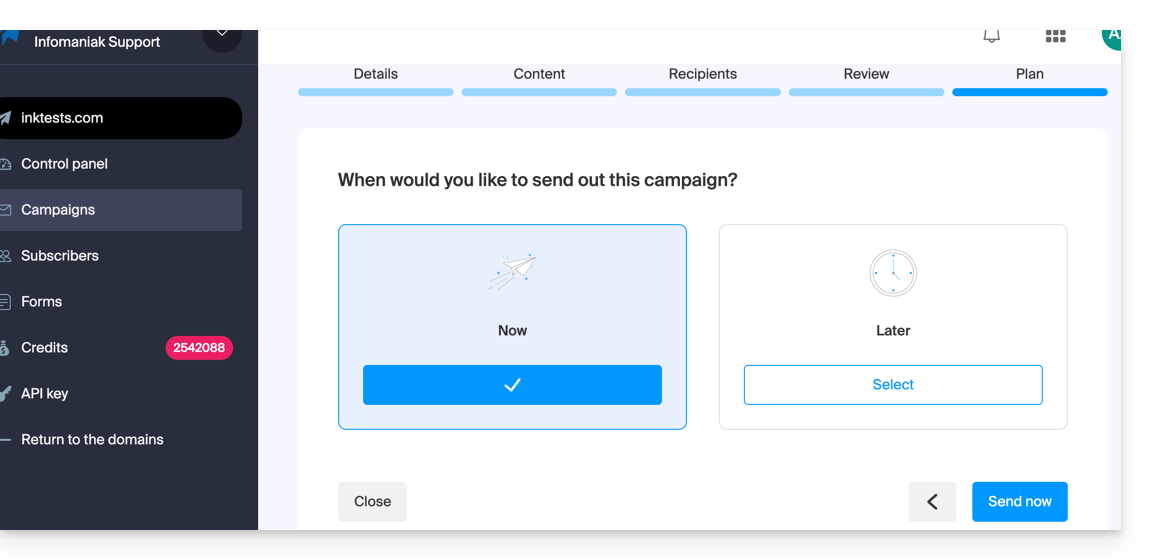
The send will then take place over several hours depending on the overall volume of Newsletters being sent, the number of your recipients, and the hourly quota allowed for your account. You will be informed of the progress of your send.
This guide covers the Newsletter by Infomaniak and provides some use cases around user registrations.
Registration and re-registration, different data...
To access your Newsletter:
- Click here to access the management of your product on the Infomaniak Manager (need help?).
- Click if necessary on the domain name concerned in the table that appears.
- The Newsletter interface is displayed.
It is possible to register multiple times consecutively for the same Newsletter (including re-registration of the user after unsubscription):
- The registration date displayed on the subscriber management page will always correspond to the first registration (even if the registrations are multiple and even if the user has not unsubscribed in the meantime):
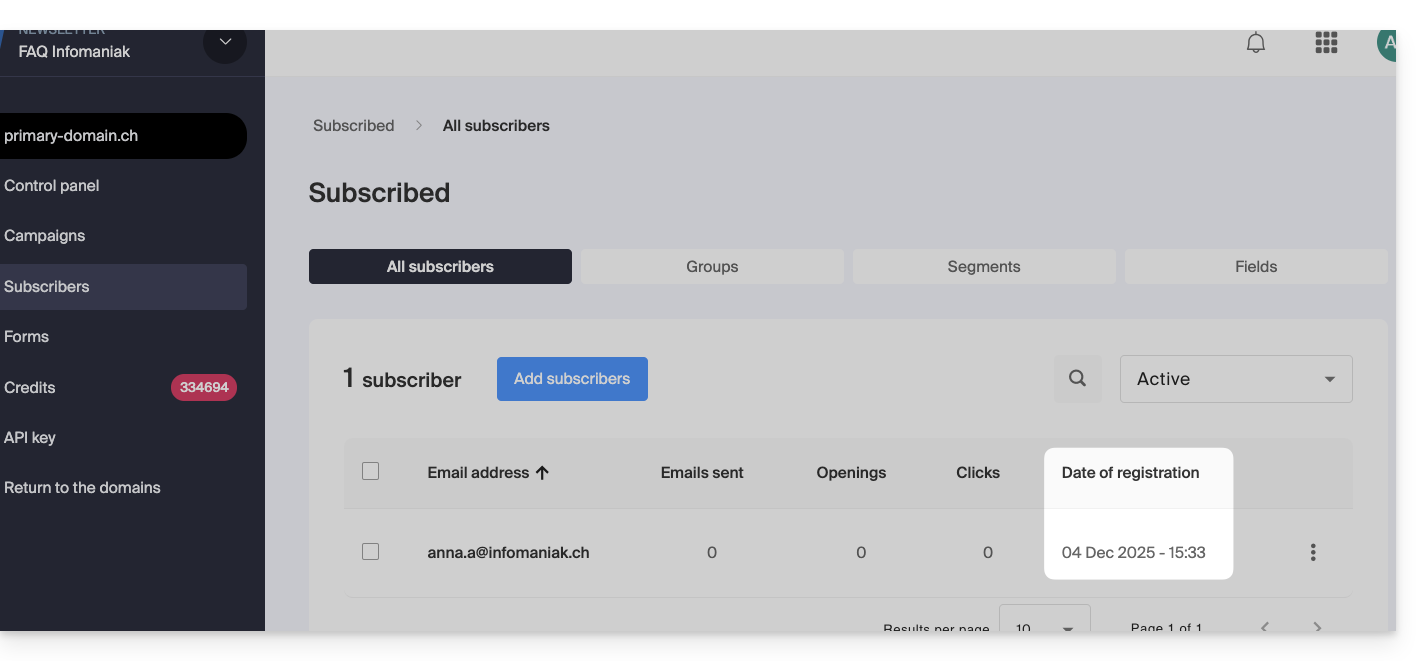
- If the user re-registers without being unsubscribed but provides other information upon registration (different name, for example), this new information will be applied
Unsubscription, deletion, and forgetfulness
The Newsletter manager can perform 3 actions on a subscriber's record: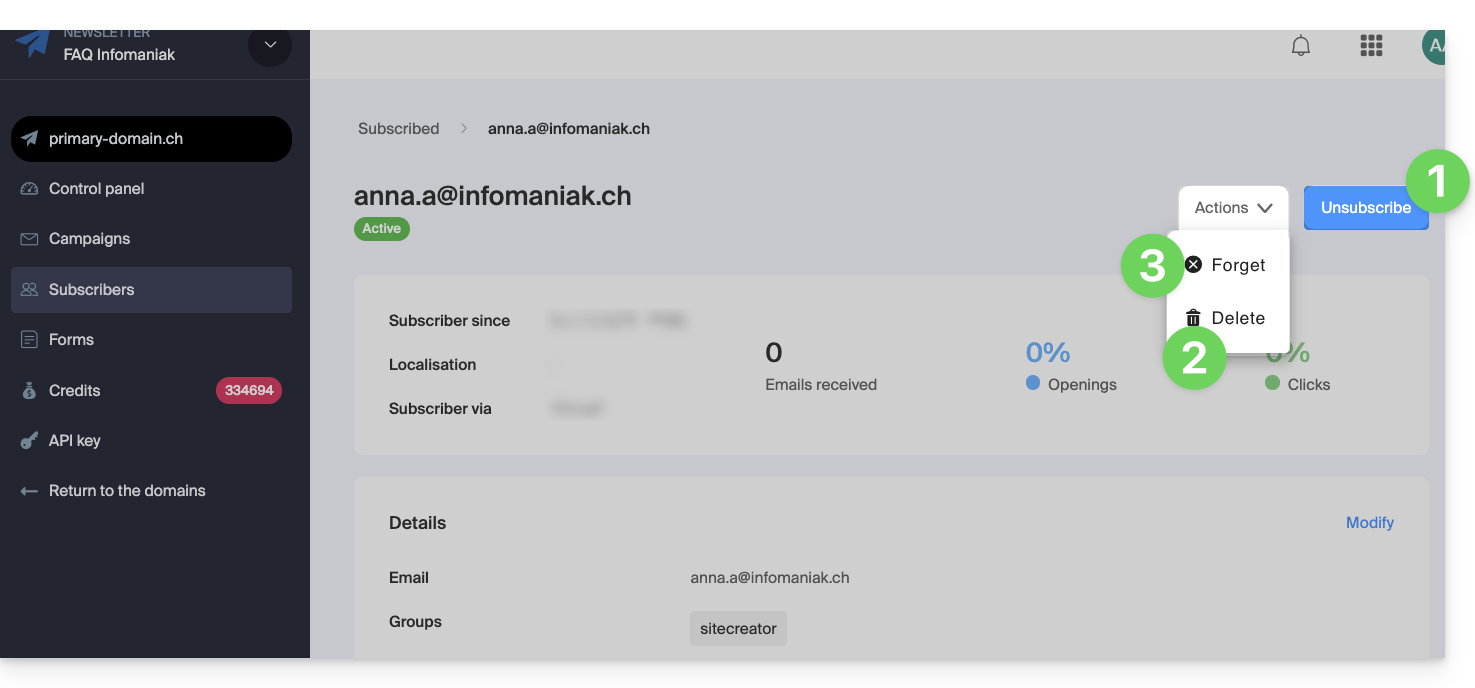
1. Unsubscribe the subscriber manually
In this case the subscriber
- becomes unsubscribed
- will no longer receive the Newsletter
- remains visible in the lists (by activating the Unsubscribed filter)
- can be modified via a re-import, unique or otherwise, but their subscribed or unsubscribed status will remain the same
- and it is possible to re-register them manually from their subscriber record:

No email is sent to the user during these operations.
2. Delete the subscriber
In this case, the subscriber (registered or unregistered)
- is deleted from the lists and no search filter (or a recycling system) allows to retrieve a deleted user
- can be modified via a re-import, unique or otherwise, but its registered or unregistered status will remain the same:
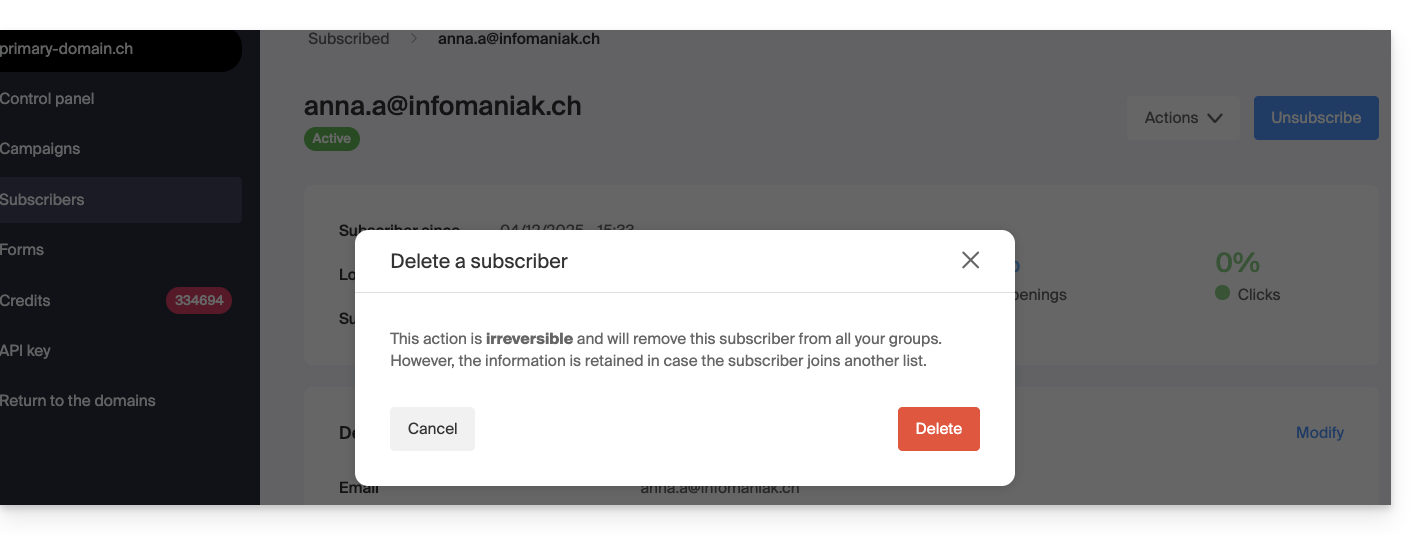
- all information relating to their activity since their first registration is retrieved and displayed
No email is sent to the user during these operations.
3. Forget the subscriber
In this case, the result and the possibilities are exactly the same as for the deletion (point 2 above) except that:
- after 30 days, all information relating to their activity is irretrievable:
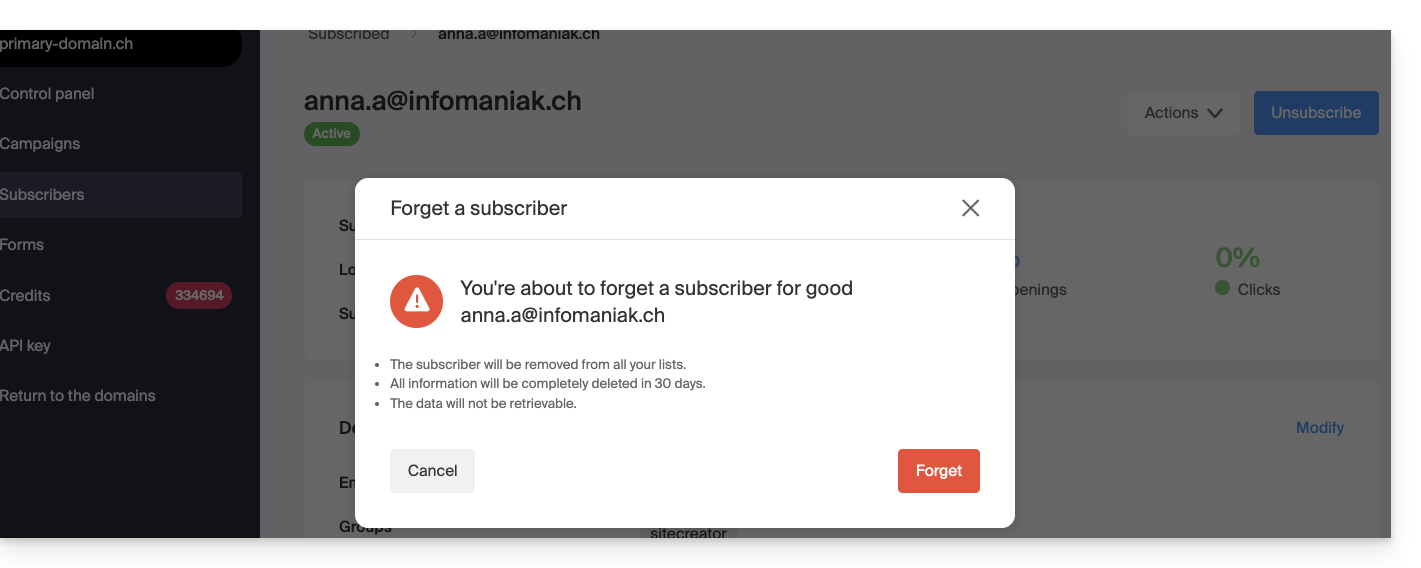
No email is sent to the user during these operations.
This guide details the reasons why sending a Newsletter via Infomaniak may be blocked, as well as best practices to prevent these blocks in the future.
Common causes of newsletter blocking
Sending a newsletter can be interrupted in the following cases:
- an excessive number of recipient email addresses are invalid or non-existent, generating a high bounce rate.
- a high rate of spam reports from recipients.
As a mail host and newsletter sending service provider, Infomaniak is required to implement strict mechanisms to combat spam.
Indeed, if Infomaniak's IP addresses or domains are listed on blacklists, this would compromise the deliverability of all emails sent by its customers, including those in compliance, and harm the overall reputation of the service.
Preventing blocks when sending a newsletter
To do this:
- Use only contact lists obtained with explicit consent.
- Prioritize building your lists through double opt-in forms, ensuring active validation of subscribers.
- Regularly clean your contact lists — at least once a year — with specialized services such as NeverBounce, Bounceless, Verifalia or QuickEmailVerification, to remove invalid or inactive addresses.
- Ensure that your emails clearly display your brand or company name, building trust with recipients and transparency in your communications.
- Avoid importing lists from other hosts without first performing a thorough cleaning of these contacts.
- Carefully check the targeting of your campaign to ensure that only relevant and consenting subscribers receive the newsletter.
What to do in case of a sending block?
In case of a block, contact Infomaniak support quickly to diagnose the cause and get assistance to complete the blocked sending.
This guide concerns the configuration of the Infomaniak product Newsletter in the case where the domain name used to send your emails is not managed by Infomaniak.
Preamble
- For automatic use of the Newsletter tool, it is necessary to manage the domain name from which you send your newsletters (as well as its DNS zone) with Infomaniak.
- For example, if you send your newsletters from the address
news@domain.xyz, the domaindomain.xyzmust be managed with Infomaniak.
Specific DNS configuration
To use the Newsletter tool with a domain not managed by Infomaniak, you will need to add specific entries to your DNS zone provided in your Manager: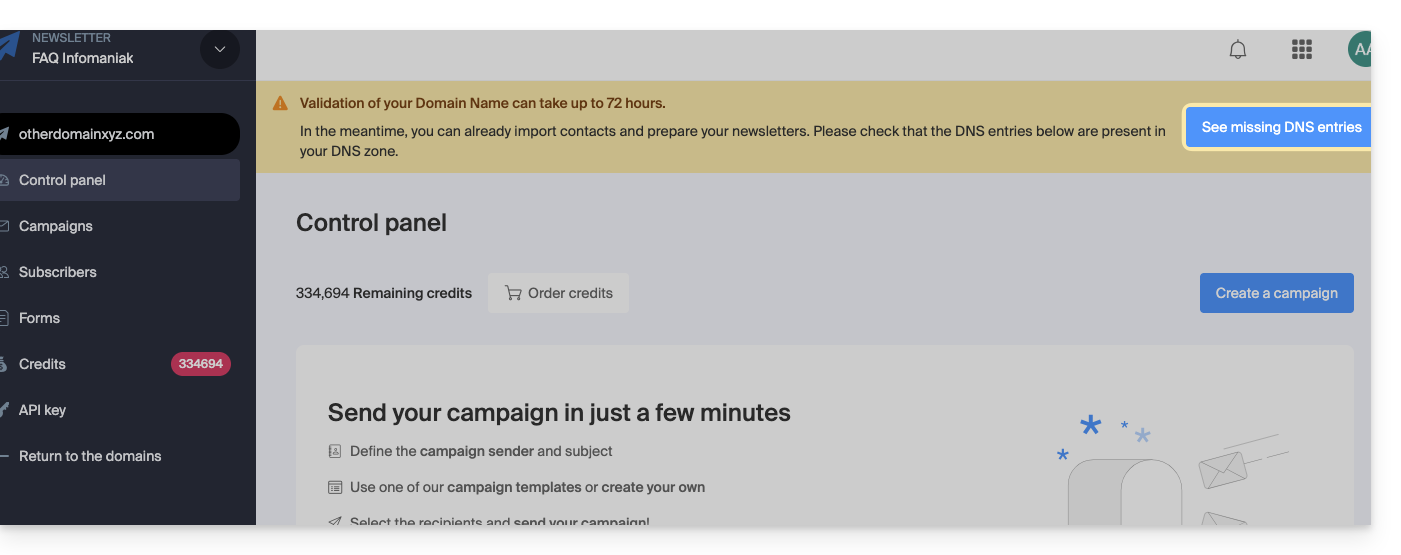
Refer to this other guide to add the DNS entries mentioning ._domainkey making sure to choose the type DKIM first, then the subtype CNAME when adding the DKIM.
In case of outgoing domain transfer
If the domain name currently managed by Infomaniak (and corresponding to the Newsletter) is transferred to another registrar, the Newsletter tool will be deactivated within 30 days if no corresponding DNS modifications are made.
This guide explains how the Infomaniak Newsletter credit system works.
Credits for sending newsletters
In general, 1 credit = 1 newsletter sent to 1 subscriber.
There are two types of credit:
- credits offered with each of your Infomaniak products (not carried over to the following months if not used)
- credits purchased (unlimited duration)
1. Obtain free credits
Regarding the operation of credits, it is important to specify that offered credits are only used when the total account balance corresponds to the number of offered credits.
In other words, as long as your balance is higher than the offered credits, it is your purchased credits that are consumed first. Once you reach the threshold of offered credits, these will then be debited.
Here is an example of how offered credits work:
A customer benefits from 3000 monthly offered credits. These free credits are automatically reallocated at the end of the month, provided that their credit balance is less than 3000. For example, if they have 1500 credits at the end of the month, 1500 additional credits will be added to bring their balance back to 3000 credits at the beginning of the month.
On the other hand, if they have more than 3000 credits (for example 10000 credits following the purchase of a credit pack), no additional free credits will be added as long as your balance remains above 3000 credits.
2. View and purchase credits
To access the page for free and paid credits:
- Click here to access the management of your product on the Infomaniak Manager (need help?).
- Click directly on the domain name assigned to the product in question.
- Click on Credits in the left sidebar.
- You can go to the credit purchase page and get more details by clicking on the blue Get credits button:

- You can purchase Newsletter credits by clicking on the Order credits button, or:
- click on Details to view the credits obtained through the rest of your products
- click on the blue button to know the credits that the rest of your products bring you

3. Set a monthly usage limit
To do this:
- Click here to access the management of your product on the Infomaniak Manager (need help?).
- Click on the action menu ⋮ located to the right of the item in question.
- Click on Set a sending limit:

- Enable the toggle switch to be able to set a limit value.
- Enter the number of email sends (= credits) allowed per month.
- Click on Save:
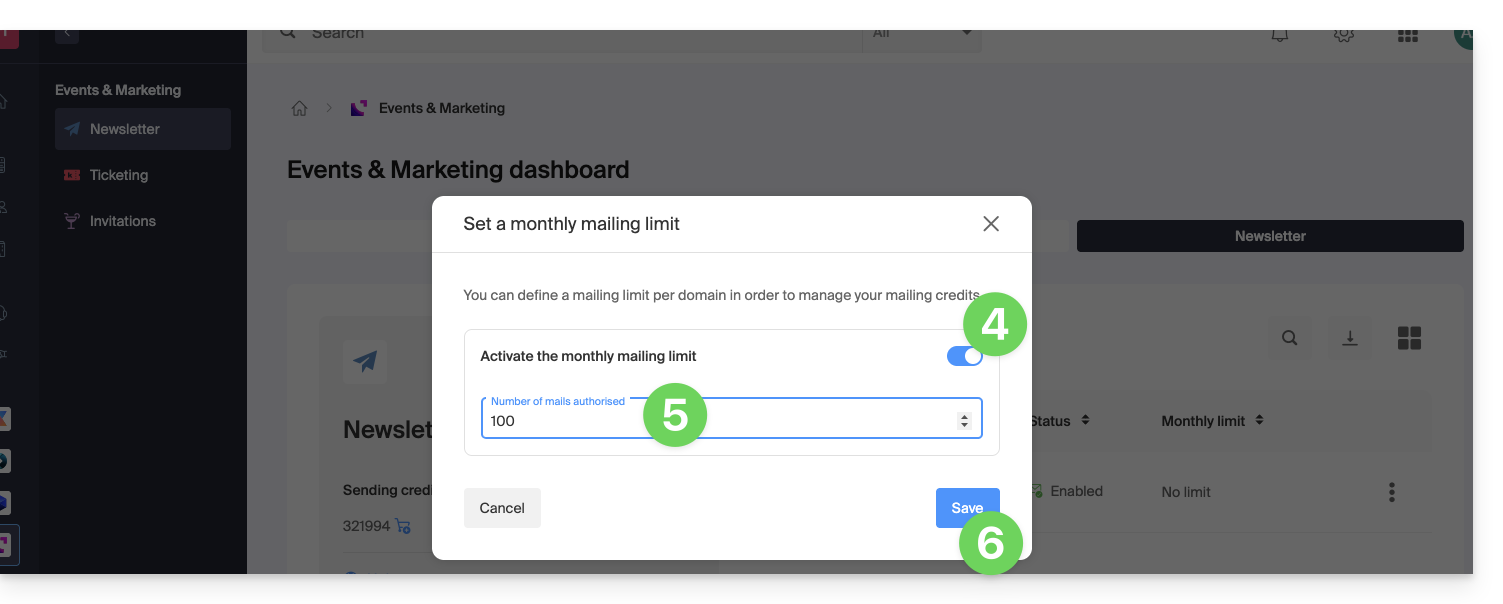
This guide explains how to enable or disable tracking in your next Infomaniak Newsletter.
Preamble
- A tracker is a small element (a 1-pixel image or a special link) inserted in the Newsletter.
- When the recipient opens the email, the image is downloaded from the sender's server, which records the opening.
- Not all email software/clients automatically load images, and some users choose to disable them; this means that a person who has read the email may be counted as never having opened it.
- The links in the Newsletter are transformed into redirect links via the tracking server, thus recording the clicks.
- Some email tools, like Outlook, automatically explore the links contained in the email, thus recording an opening even if the user never consulted it.
- Trackers are used to collect various data useful for marketers, such as:
- Open rate to know how many people opened the Newsletter
- Opening time to determine when the newsletter is opened
- Geographical location based on the recipient's IP address
- Device and software type to know the device (computer, smartphone, tablet) and the software (browser, email software/client) used to read the Newsletter
- Click-through rate to measure how many people click on the links in the Newsletter
- Conversions to track if the recipients perform specific actions after opening the Newsletter (purchases, registrations, etc.)
Enable statistics collection
Activate this option at the very first step of creating your Newsletter:
- Click here to access the management of your product on the Infomaniak Manager (need help?).
- Click on the domain name concerned in the table that appears:

- Click on Campaigns in the left sidebar.
- Click on Create a campaign:

- Turn on the stats parameters using the toggle switches:

By deactivating statistics, the URLs of the links you insert within the body of your Newsletter will no longer be transformed, and you will not receive statistical feedback on the usage of your Newsletter by your recipients.
Refer to this other guide regarding the last option on the page.
This guide explains how to create a subscription form for the Infomaniak Newsletter tool, how to integrate it on a Web page and how to manage subscriber sends and unsubscriptions.
Preamble
- The management page lists the already created forms and indicates the number of views and conversions of these.
- A conversion is a completed form, without necessarily the person having confirmed e.g. their email address.
Create a subscription form
Prerequisites
- Have created at least one group.
A subscription form allows visitors to a website to subscribe to a newsletter and enrich one or more contact lists / groups (see prerequisites above). To access form management:
- Click here to access the management of your product on the Infomaniak Manager (need help?).
- Click directly on the Newsletter domain name.
- Click on Forms in the left sidebar.
- Click on the blue button Create a form:

- Give a name to your form.
- Specify the contact group that should be incremented by the subscriptions made on this form.
- Click on the button to continue:

You are then on the space to customize your form.
A. Customize the content and generate an HTML / javascript code
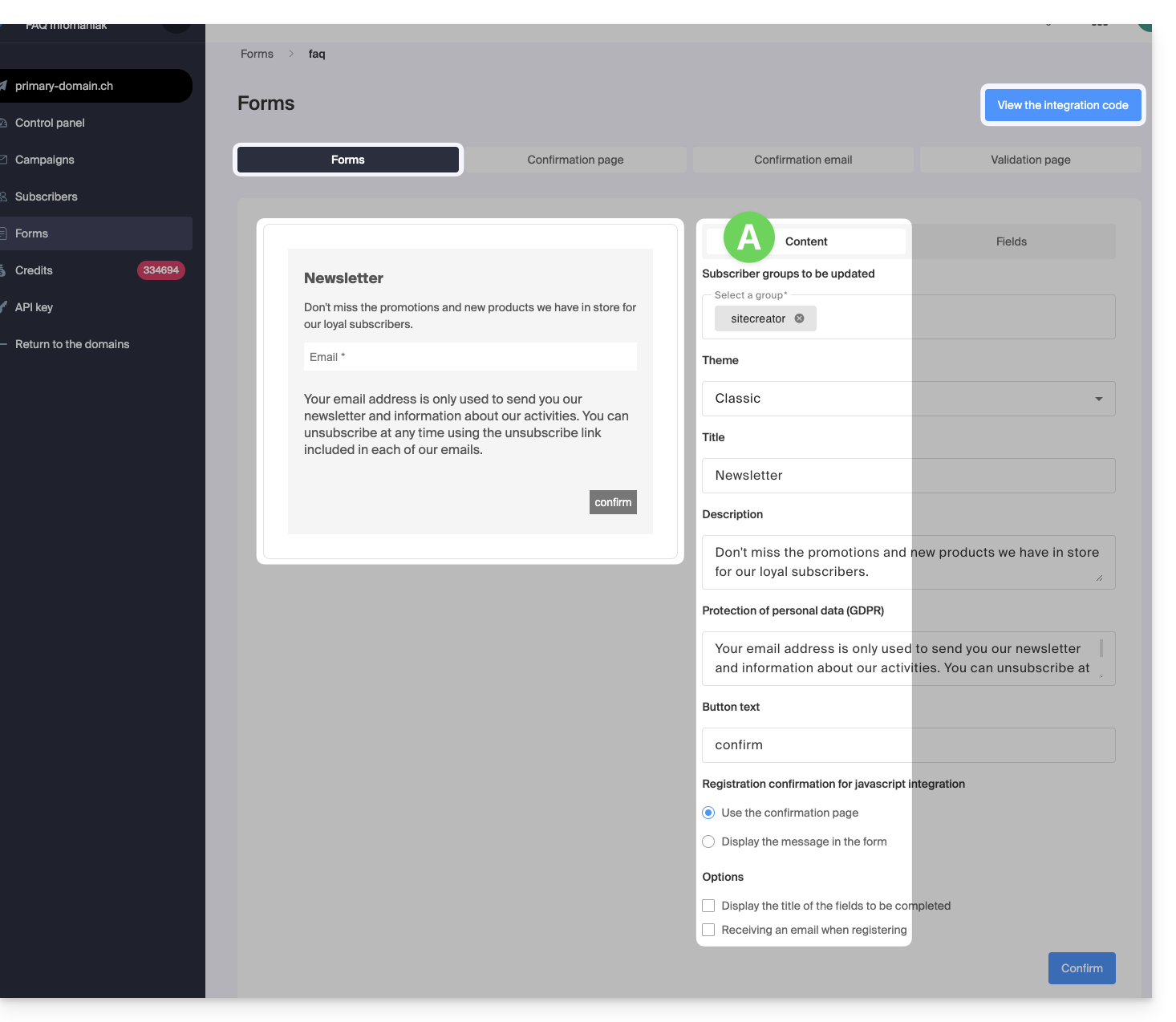
- The left part previews your form.
- Specify which of your groups should contain the future subscribers of this form.
- This notably allows having a form in one place corresponding to the filling of a specific contact list, then another form elsewhere corresponding to another list, this in order to send a Newsletter that is even more personalized afterwards.
- The Theme menu allows you to give the most suitable color palette to your form so that it integrates as best as possible with the rest of the content next to which your form will be inserted.
- All form elements can be customized, including the text of the button that visitors need to click to subscribe and the confirmation text that will be displayed after this click (integration with javascript code only).
- The boxes at the very bottom under Options allow you to
- display the title above the fields instead of displaying them inside
- receive an email (as a Newsletter manager) when someone uses the form to sign up
- Click on the blue button at the bottom of the page to save your changes as you go.
- Click on the blue button at the top of the page to display the javascript code and HTML code to integrate on your pages (be aware of this other guide on this subject) if you have finished or continue to customize your form before copying the code.
B. Manage the information collected from the subscriber (configure the fields)
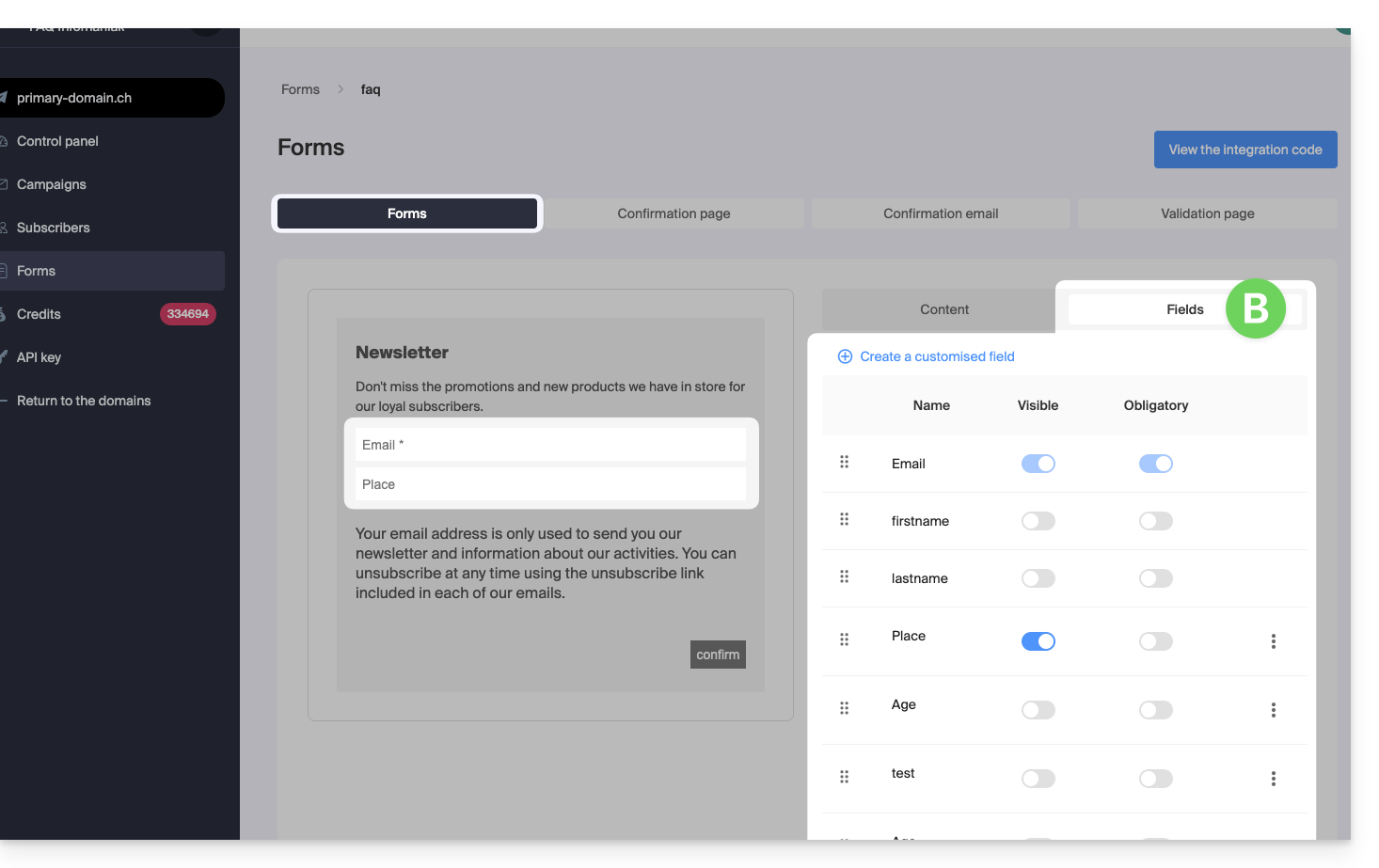
The Fields tab lists any already configured fields and allows you to configure new ones (button Create at the top of the tab):
- These fields can be textual, of type “date” or that force the insertion of numbers only.
- The “Required” column allows you to activate the required status of the field, which forces the subscriber to complete the required information, otherwise the subscription will not be allowed.
- The information collected by these different fields will be stored on the subscriber's record and can be used as a variable in your Newsletter and inserted into the body of the Newsletter when writing it.
- Click on the blue button at the bottom of the page to save your changes as you go.
- You can delete the fields from the Subscribers section.
C. Continuation of the subscription configuration
The following tabs allow you to manage the rest of the subscriber's journey: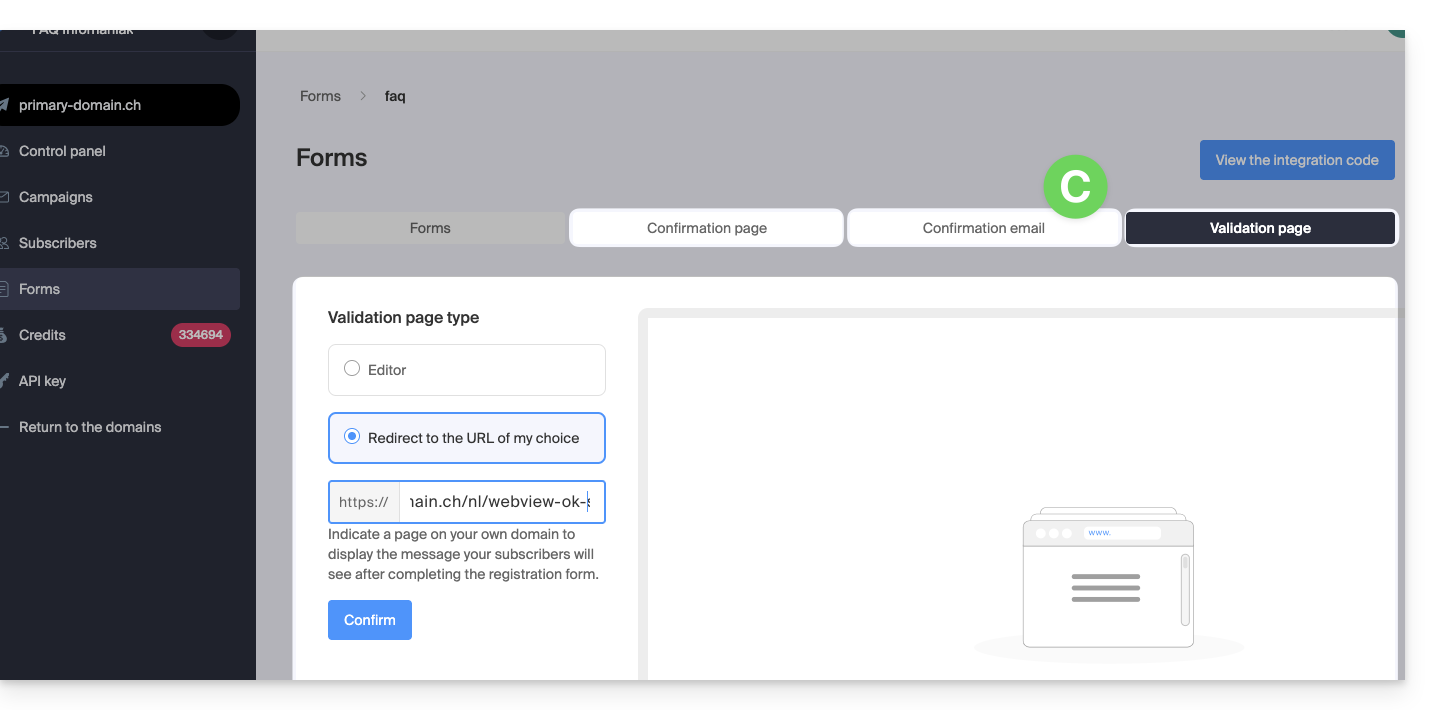
Indeed, a visitor's subscription via the form works on the principle of double opt-in: a first message is sent to the address of the person who has signed up, who must manually and voluntarily validate their subscription by clicking on a unique link contained in the received email.
Only then will the person be definitively subscribed to your database as a subscriber, until their possible unsubscription.
You can therefore, through the next 3 tabs:
- customize the page or text that should be displayed during the first phase of subscription (which informs the user that an email has been sent to them)
- customize the email that is sent to the user who wishes to subscribe (content, sender, title, etc.)
- customize the page or text that should be displayed when the user confirms their subscription by clicking on the link contained in the body of the email
This guide concerns the links present in the Newsletter that you have written.
Invalid links?
If you perform a test send of your Newsletter…
- Click here to access the management of your product on the Infomaniak Manager (need help?).
- Click on the domain name concerned in the table that appears:

- Click on Campaigns in the left sidebar menu.
- Click on Create a campaign:

- At the content drafting stage, if you send a test (dedicated button for this purpose in the top bar) to the address of your choice…
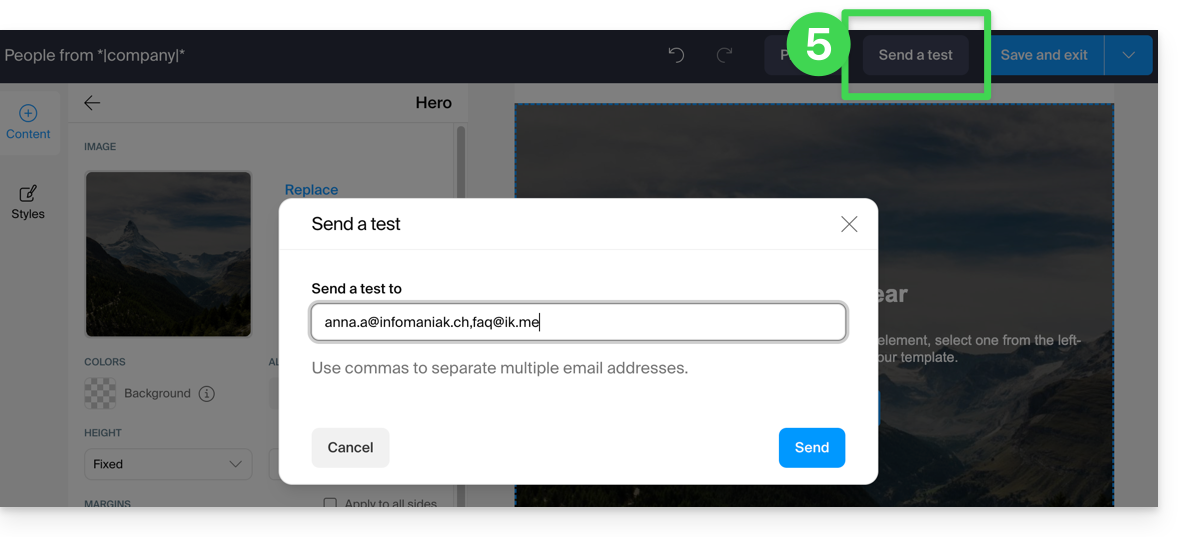
… then it is normal that the links present in your message sent during the test (upper part: "VIEW THIS EMAIL IN MY BROWSER" = link to view the message in a browser and lower part: "UNSUBSCRIBE" = link to allow the user to unsubscribe) do not work.
They will obviously be functional during your final send.
This guide explains how to add tags (codes and variables) in the body of your text to customize your sends with Infomaniak Newsletter.
Preamble
- A subscriber exists in the form of an email address, but not only:
- You may have additional details about them, which must be included in the file you import so that you can define a custom field associated with each of these additional details.
- Many other details can be collected during the subscription of a subscriber via a form.
- You can add many other details manually at any time.
- The information associated with each subscriber can be used to segment your audience, send targeted messages, and improve engagement.
- By leveraging these additional details, you increase the chances of conversion and loyalty, thus creating a stronger and more personalized relationship with each subscriber.
Manage custom fields
To view the content of each field of each subscriber, refer to this other guide (under Edit a subscriber's record).
To manage the name of these fields, or simply delete or add them, go to the Subscribers section:
- Click here to access the management of your product on the Infomaniak Manager (need help?).
- Click on the domain name concerned in the table that appears:

- Click on Subscribers in the left sidebar menu.
- Click on the Fields tab:

Insert a variable...
... in the Newsletter title
When you create a new Newsletter, insert the custom fields in the subject and preview text:
- In the very first step of creation, click on the drop-down menus dedicated to this use:
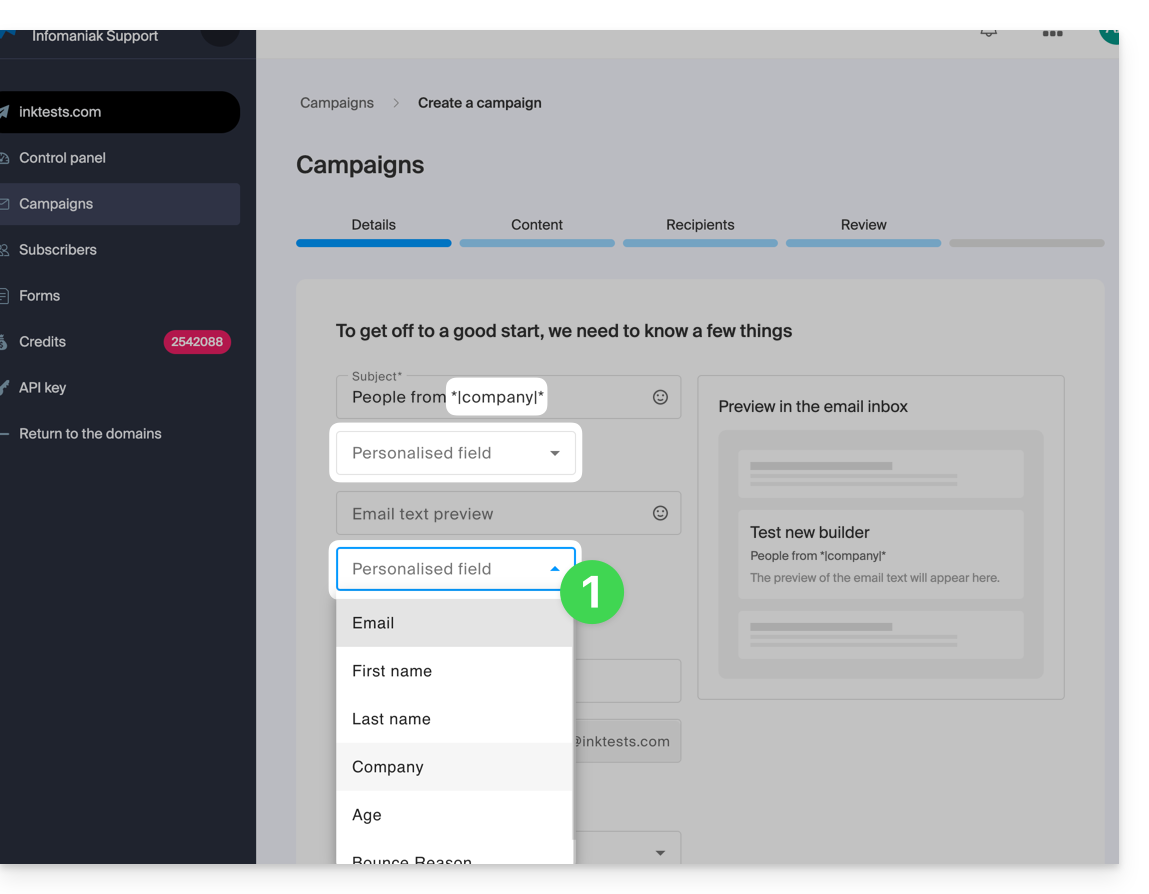
... in the body of the email
When you build your Newsletter with the block editor:
- Click on the text where you want to insert your variable.
- Click on the Tag / Label icon in the toolbar.
- Choose the variable to insert:
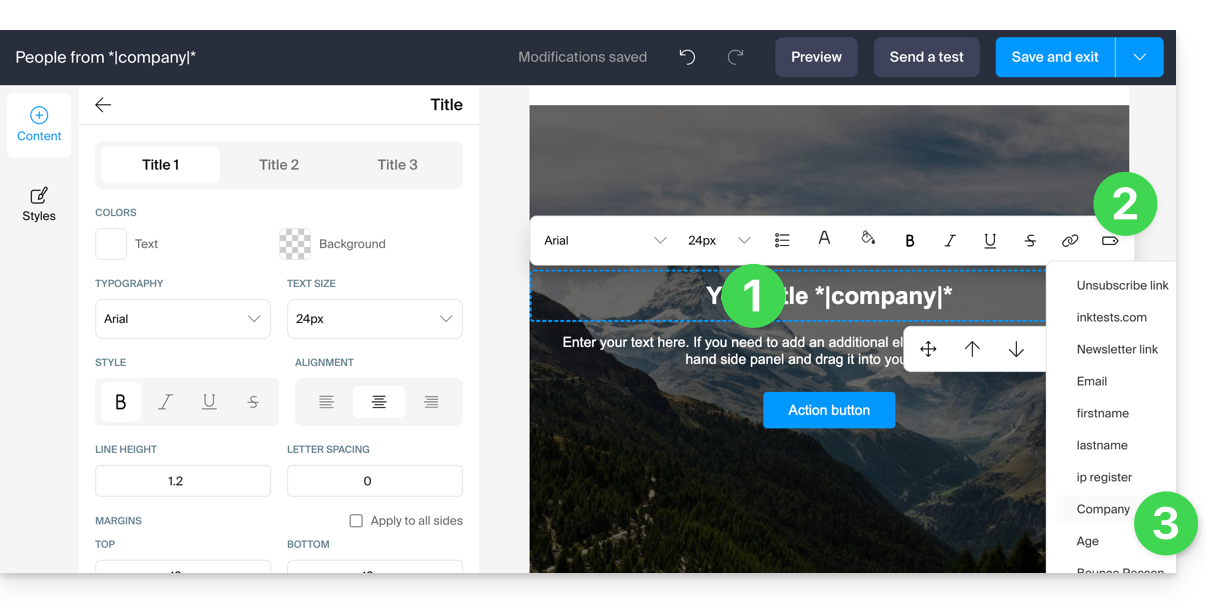
You can also simply insert the variable name surrounded by asterisks and separators: *|VARIABLE|*
List of basic variables
*|FIRSTNAME|* | first name |
*|LASTNAME|* | last name: this variable can also be integrated into a link href for example https://domain.xyz?name=*|LASTNAME|* |
*|EMAIL|* | email address |
*|DOMAIN_NAME|* | newsletter domain name |
*|IP-REGISTER|* | user's IP address when signing up |
Unsubscribe link | To place an unsubscribe link ('unsubscribe') at the desired location without any action on your part, this link is automatically inserted at the bottom of your newsletter |
Newsletter link | To manually add a link to an online version of your newsletter without any action on your part, this link is automatically inserted at the top of your newsletter |
This guide shows you how to create / import / manage contacts within subscriber lists for Infomaniak Newsletters.
Preamble
- You must obtain the explicit consent of your recipients via the double opt-in model:
- Sending spam and using purchased/rented address lists is prohibited.
- Importing does not send any message to the added contacts (so read and accept the points above).
- Duplicates will be automatically removed.
- If you re-import an address that is already subscribed, the different custom fields will be updated.
Create a subscriber list
To access the management of Newsletter subscribers:
- Click here to access the management of your product on the Infomaniak Manager (need help?).
- Click on the domain name concerned in the table that appears:

- Click on Subscribers in the left sidebar menu.
- Click on the blue Add contacts button:
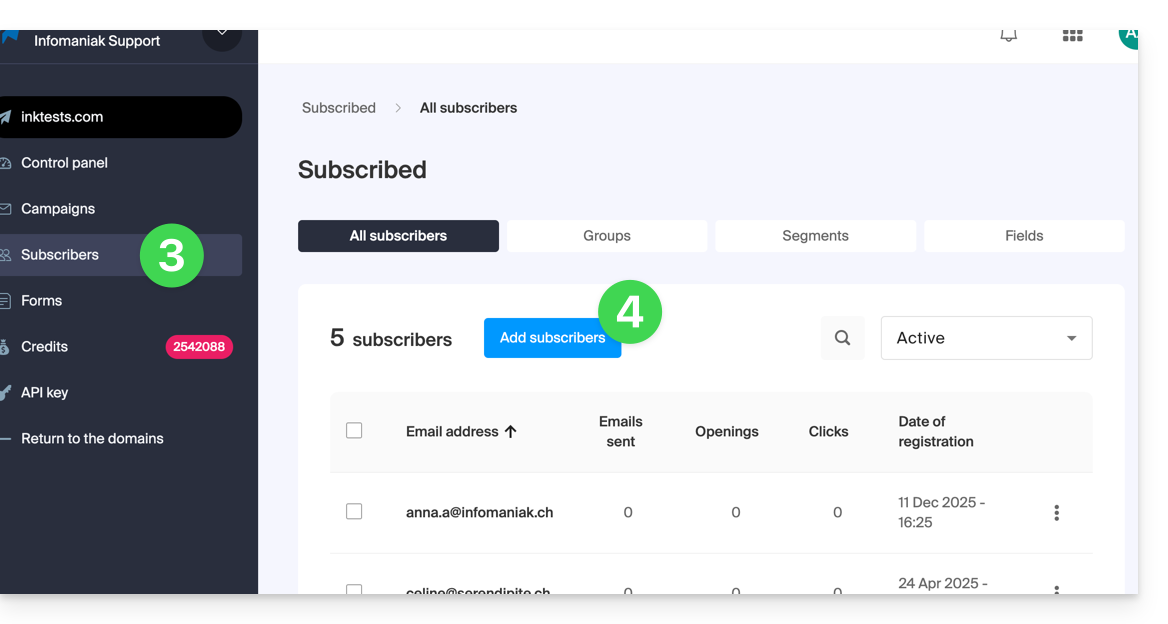
- Read and accept the Terms of Service.
- Choose from the different ways to create a subscriber list:
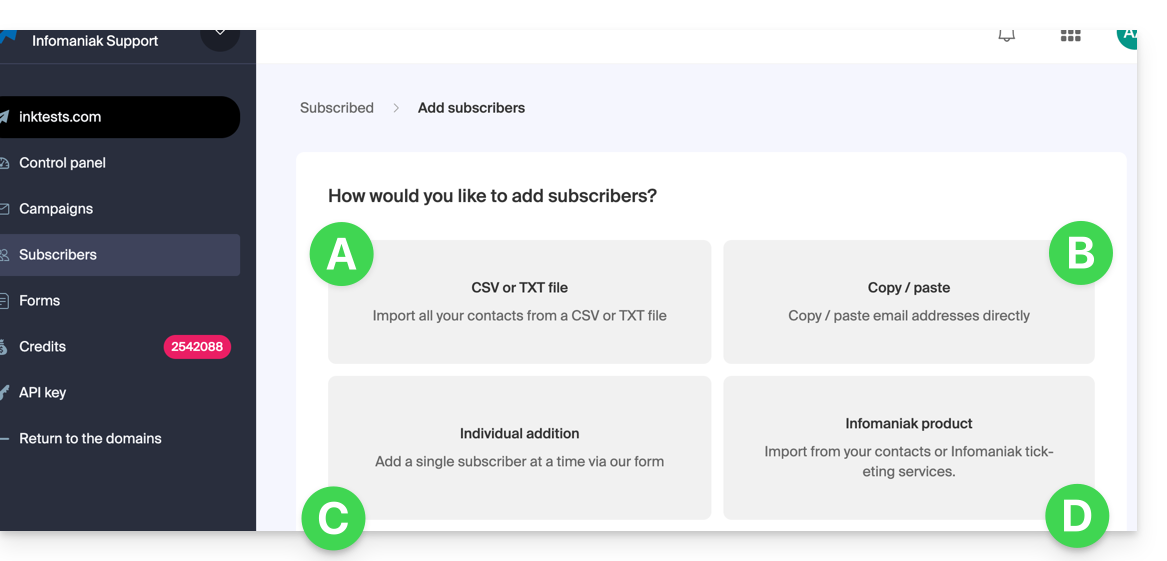
A. Import a CSV file (format .csv) or .txt file (predefined format)
- The format must be respected (a template to download is available as an example on the page). Maximum size: 300 MB
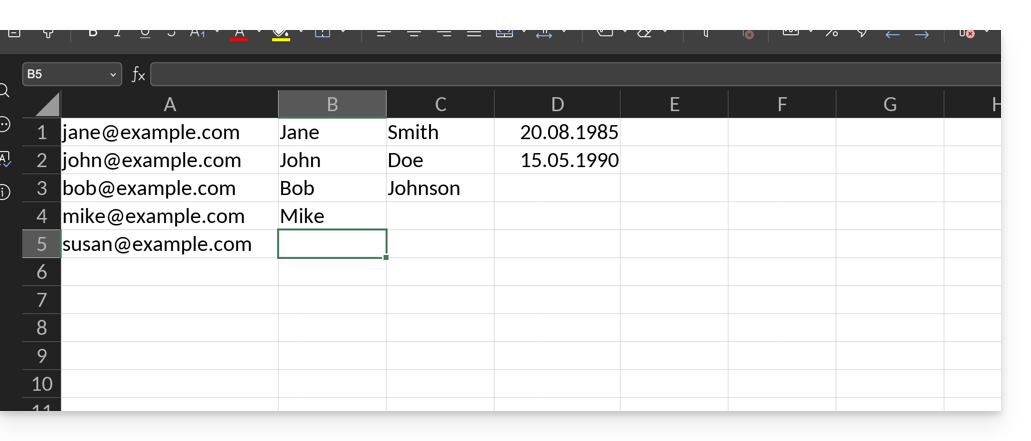
- Once the spreadsheet-type document is written, export it as
.csvwhich will create a kind of text document with a separator between each piece of information in the different cells: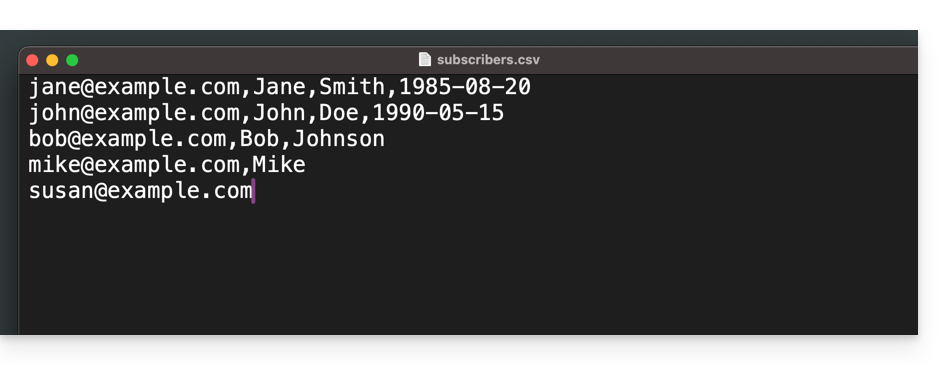
- Select the
.csvfile from the import interface, then click on the blue Import button: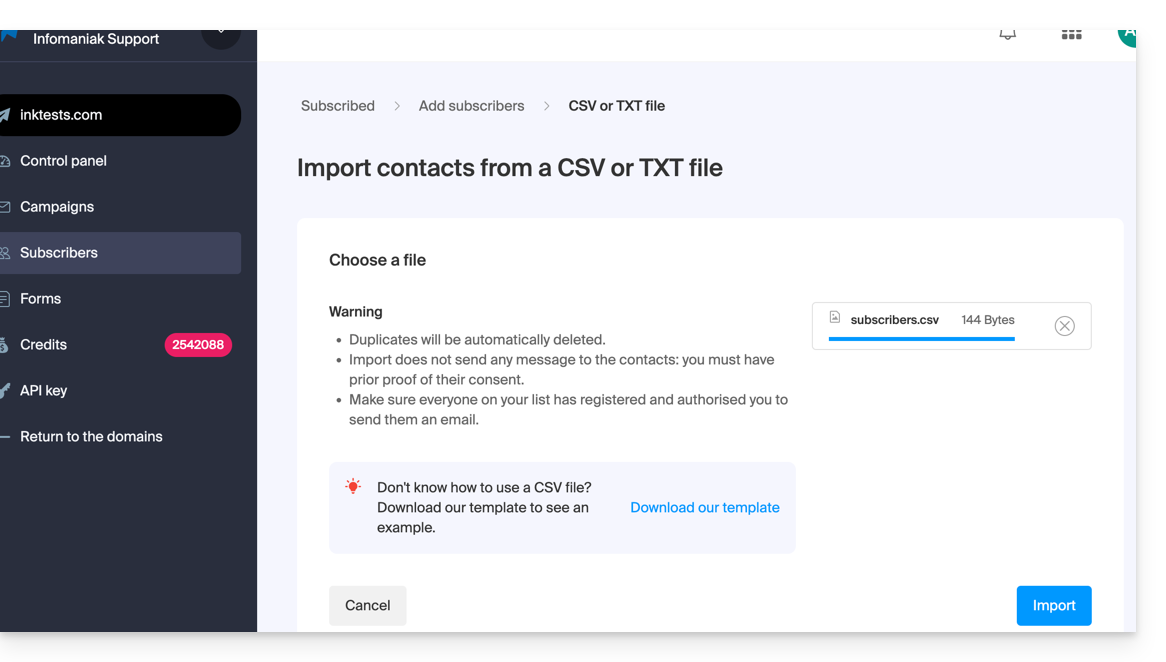
- You need to assign the desired field to the desired information (the information is grouped according to the original columns).
- At the bottom of the drop-down menu, it is possible to create the fields that do not yet exist (the type of field can be forced to numbers or a date, boolean, etc.).
- Choose a potential group from your created groups in which to place the imported contacts:
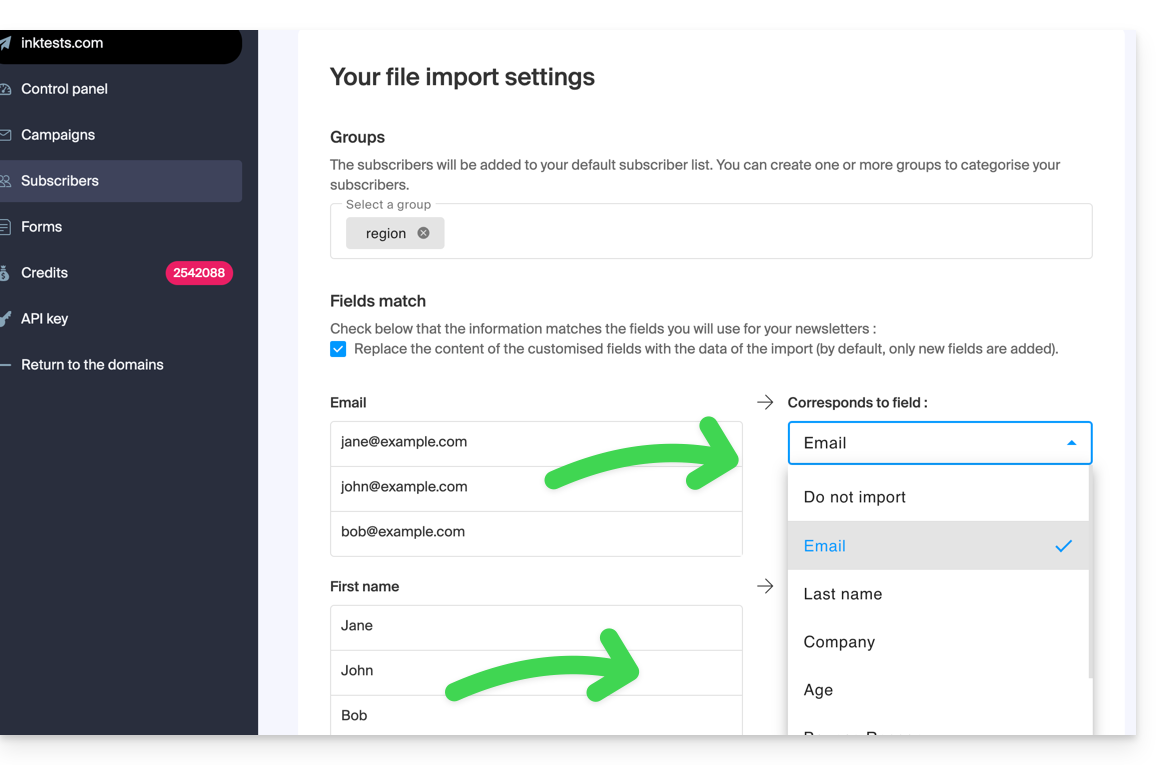
- There you go, whether under Groups or under Subscribers, your import is visible.
- If this is not the case, check if they are visible with the display filter “All”:
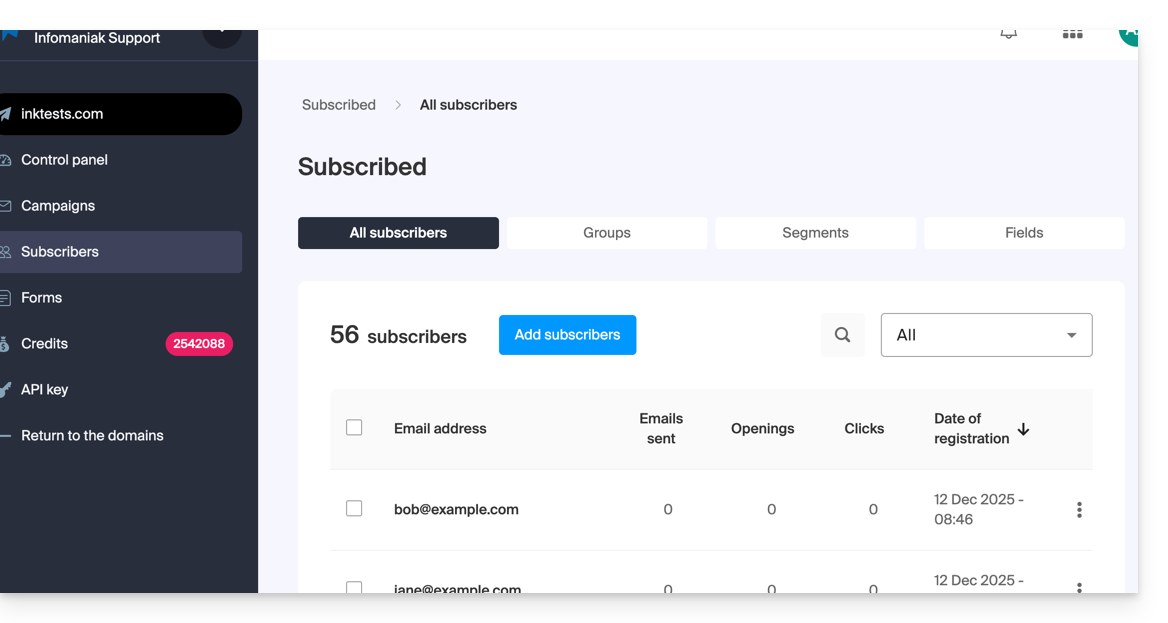
- It may be that after an email verification, the status of the imported subscriber is invalid, so you will not be able to write to them:
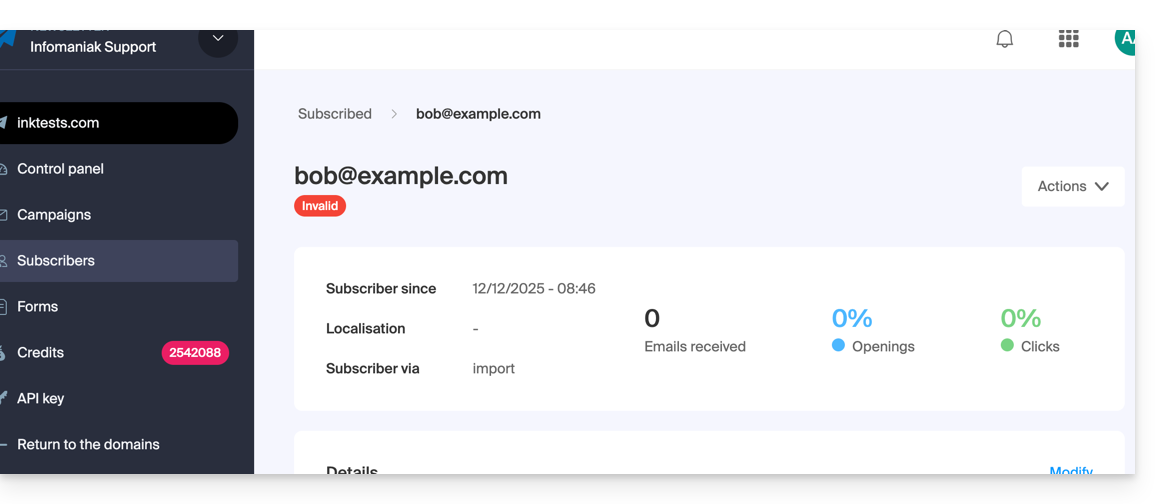
- If this is not the case, check if they are visible with the display filter “All”:
B. Copy and paste the equivalent of a .csv or .txt (predefined format)
- The format must be respected, as in the file to download (see above), for example:
anna.a@domain.xyz,Anna,Alpha,1985-08-20
alfred.a@domain.xyz,Alfred,Alpha
contact@domain.xyz,Support
mail@domain.xyz- Once this information is pasted into the field dedicated to this effect, click on the blue Continue button:
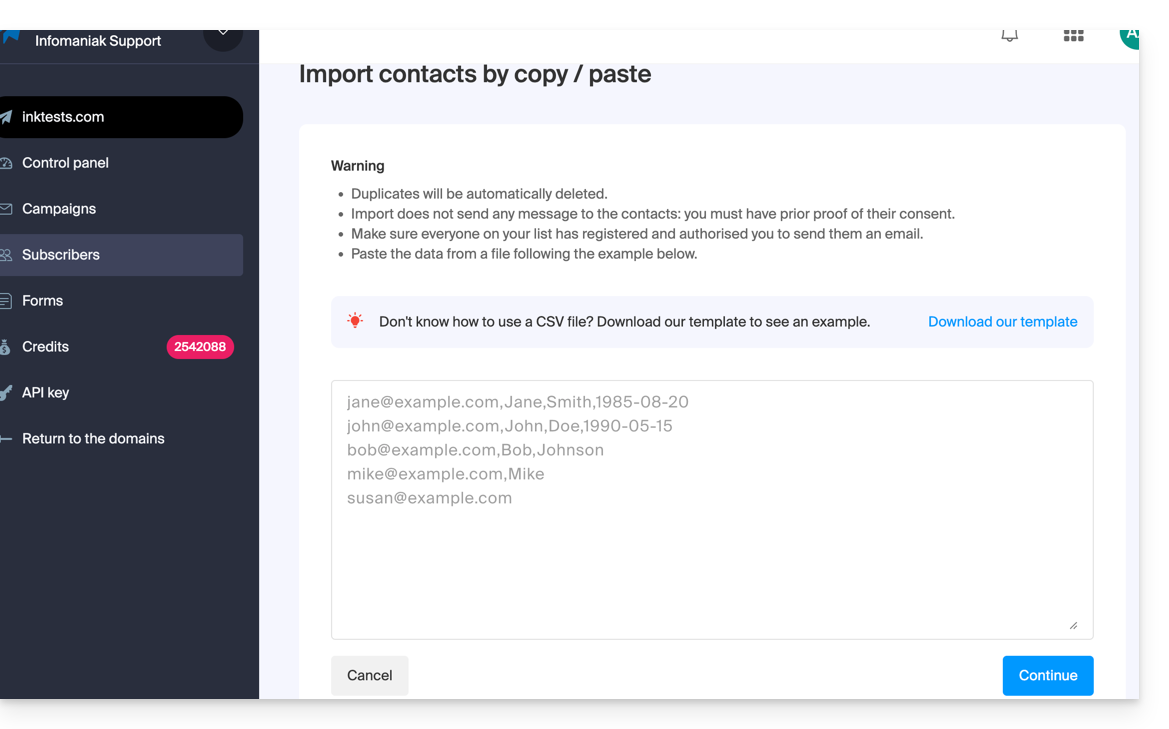
- The rest of the import is identical to point A above.
C. Filling out an individual contact form
- Import contacts one by one using the proposed form.
- Add fields if necessary (the type of field can be forced to numbers or a date, boolean, etc.).
- Specify the potential existing group:
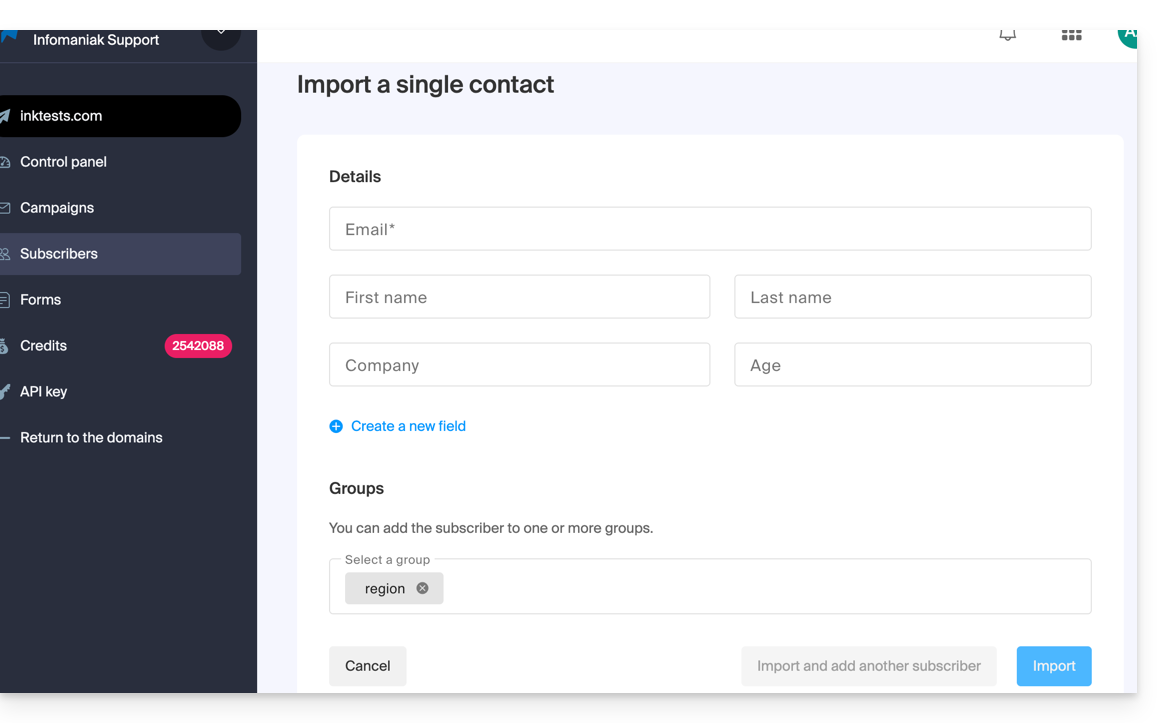
D. Automatic import from other Infomaniak tools
- Import contacts from your Infomaniak address books and from the Infomaniak ticketing tool if available (with the possibility of importing only users who have specified that they want to receive a Newsletter):
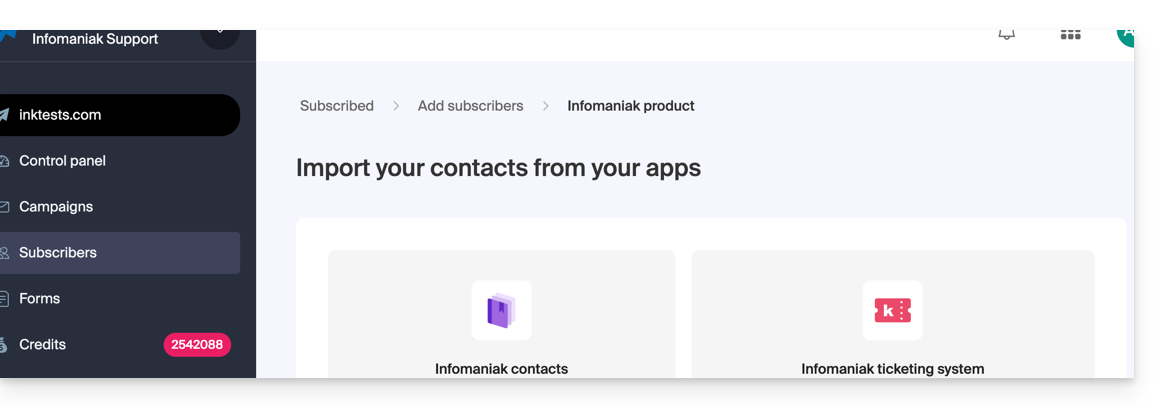
Edit a subscriber's card
To edit the information related to your subscribers:
- Click here to access the management of your product on the Infomaniak Manager (need help?).
- Click on the domain name concerned in the table that appears.
- Click on Subscribers in the left sidebar menu.
- Search or filter the type of display if necessary.
- Click on the subscriber whose details you wish to edit:
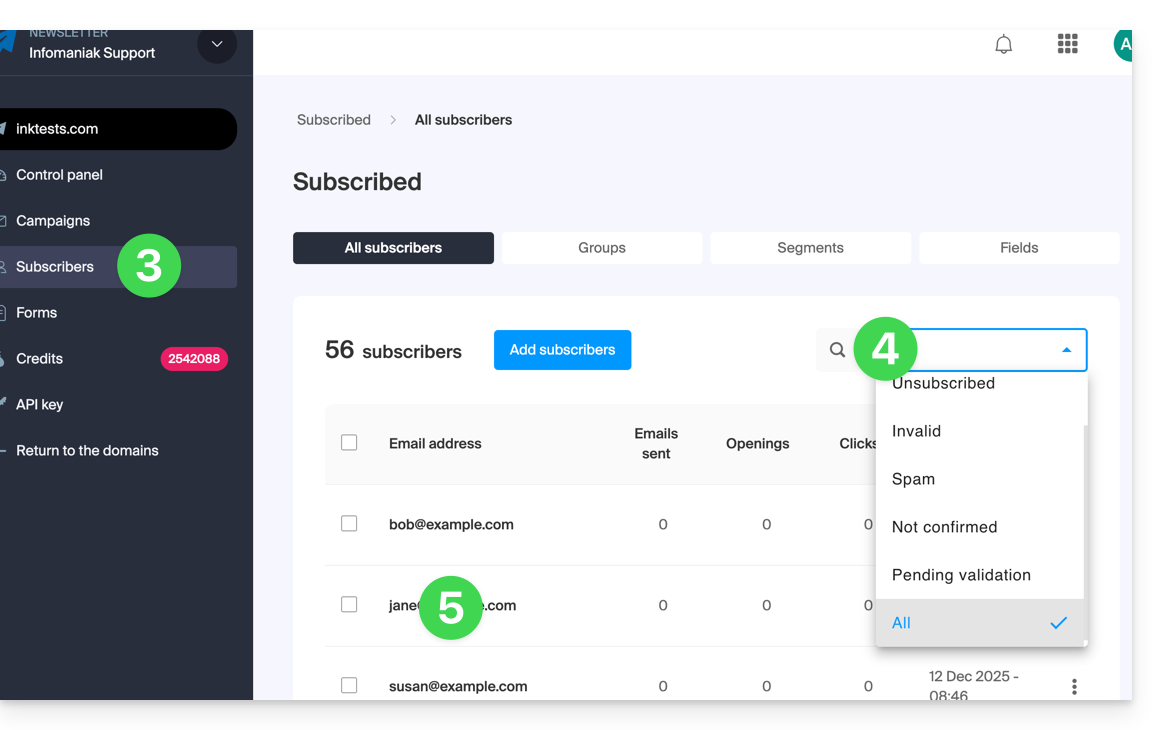
- Click on Edit:
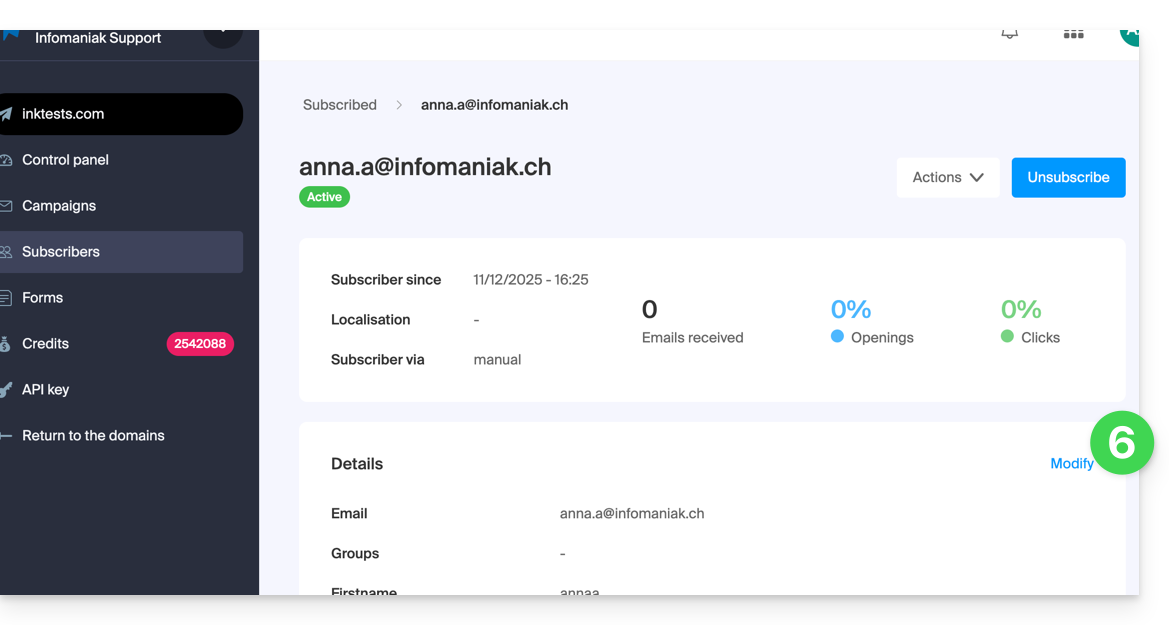
- Edit the information (only the email address cannot be modified):
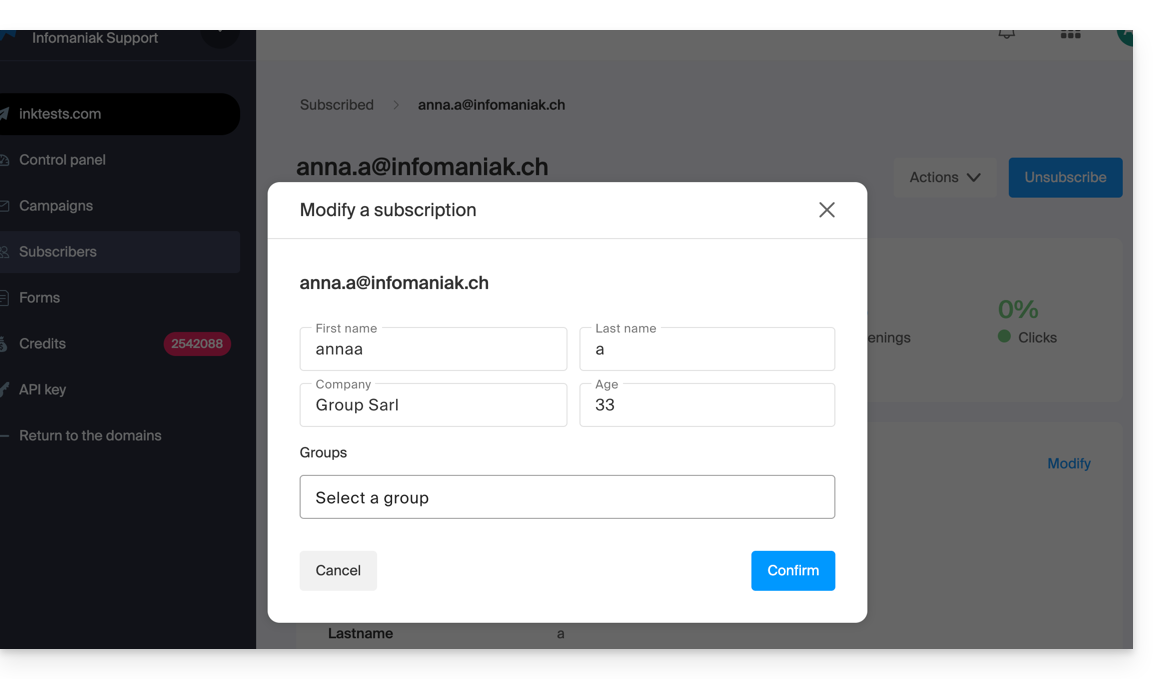
- If you wish to add a new field, you must add it globally by returning to the Subscribers menu.
- Click on the Fields tab.
- Click on Create a field.
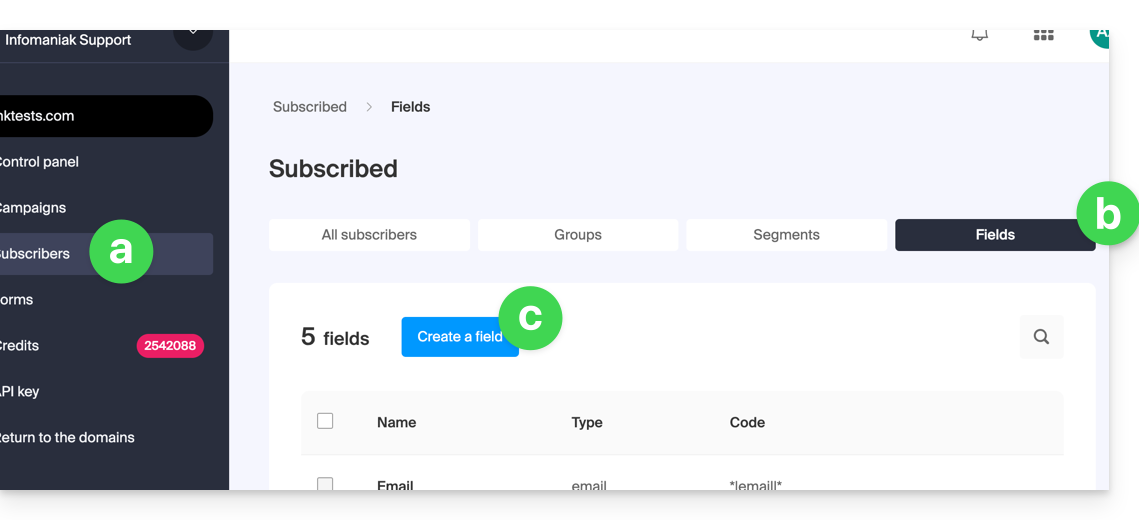
- The subscriber's card can now be edited at the level of this new field:
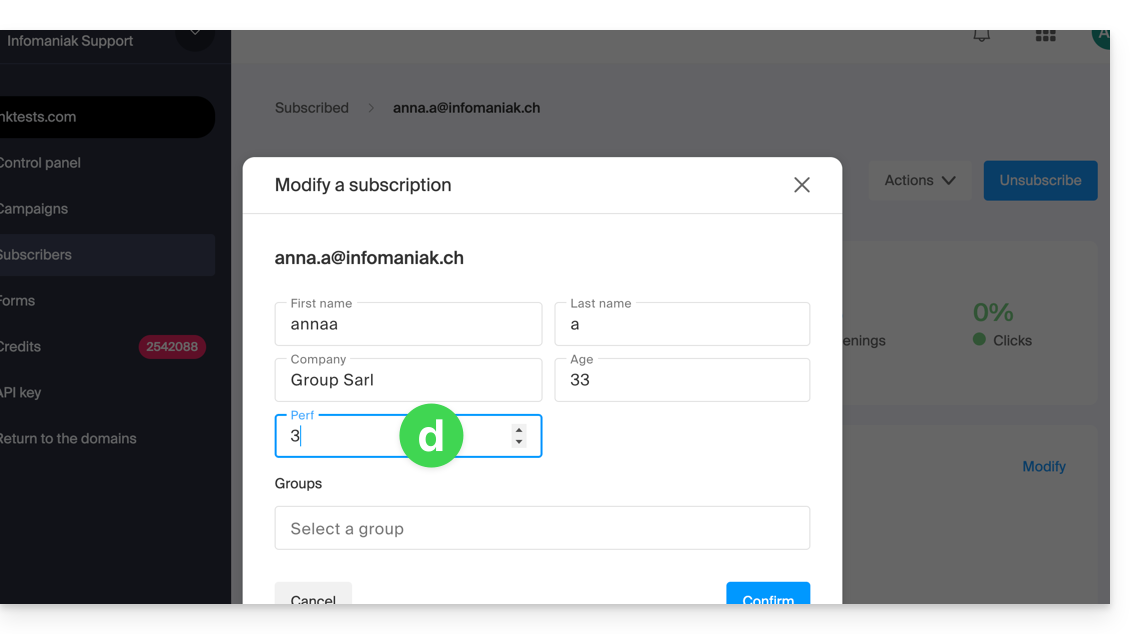
Delete subscribers
To delete newsletter subscribers:
- Click here to access the management of your product on the Infomaniak Manager (need help?).
- Click on the domain name concerned in the table that appears.
- Click on Subscribers in the left sidebar menu.
- Search or filter the type of display if necessary.
- Click on the box to select one or more subscribers.
- Click on Delete:
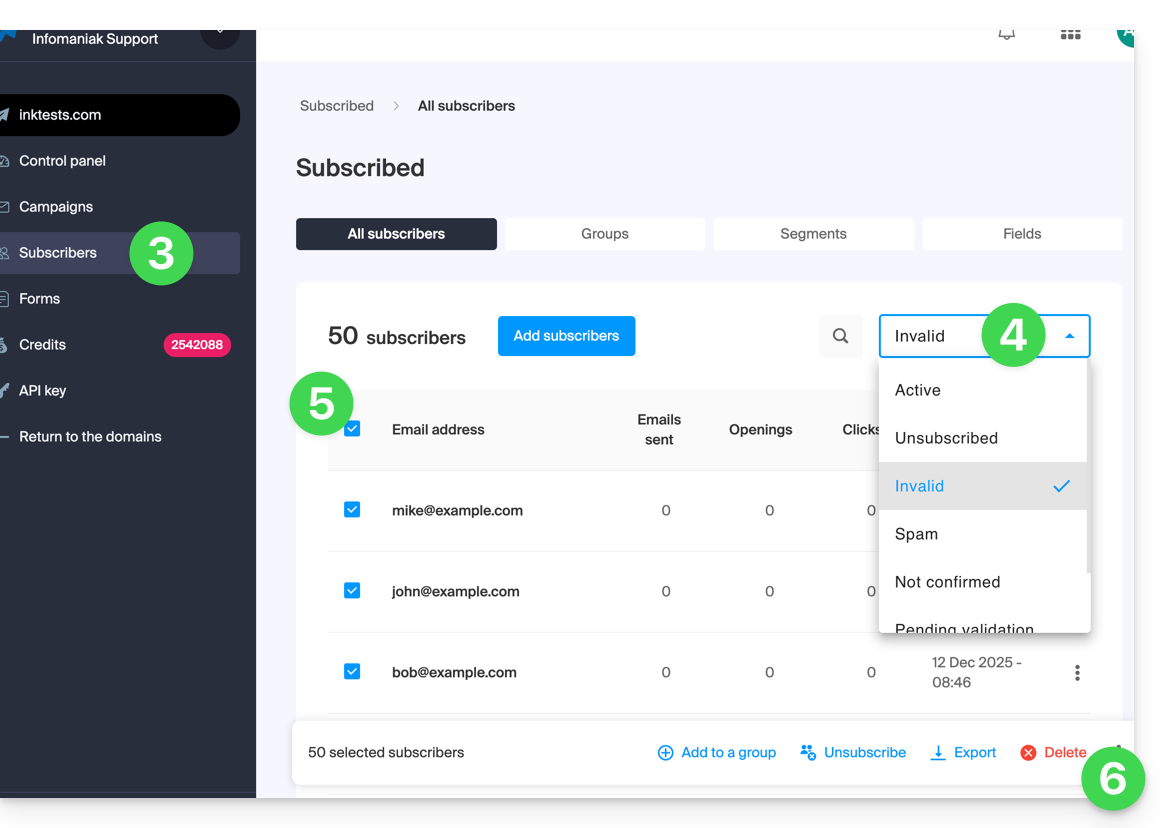
- Confirm the deletion
You can also click on Unsubscribe instead of Delete so that the contacts remain in the list: refer to this other guide.
Export subscribers
To export the list of newsletter subscribers in .csv format and according to selected criteria:
- Click here to access the management of your product on the Infomaniak Manager (need help?).
- Click on the domain name concerned in the table that appears.
- Click on Subscribers in the left sidebar menu.
- Search or filter the type of display if necessary.
- Click on the box to select one or more subscribers.
- Click on Export:
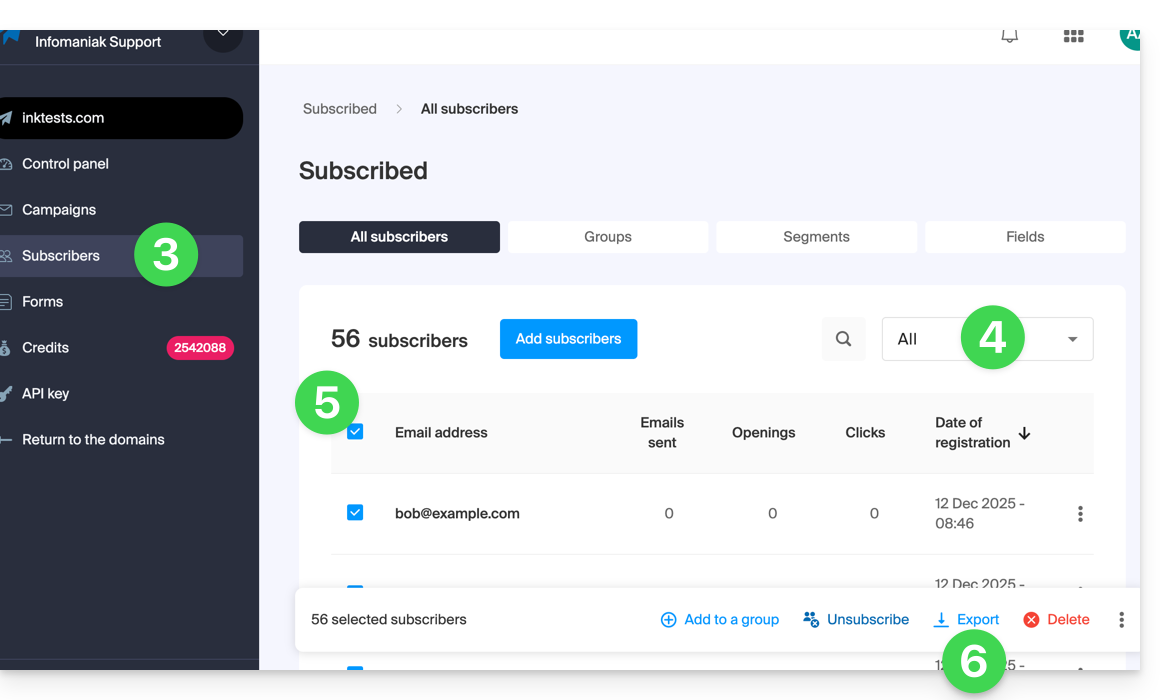
- Click on the blue button once the export is ready to download the data into a CSV file (format
.csv).
The file obtained includes these columns: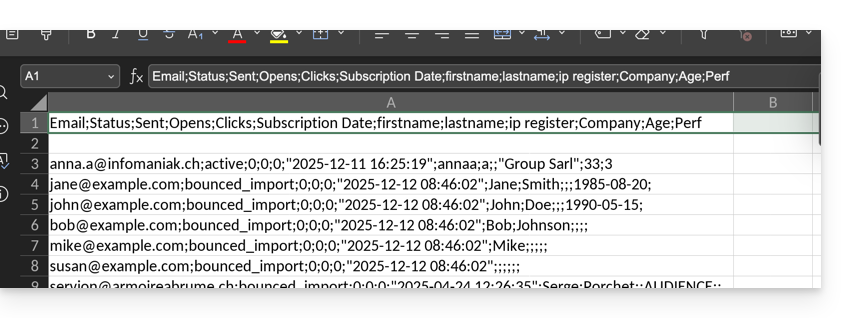
- Status
- Sent
- Opens
- Clicks
- Subscription Date
- firstname
- lastname
- ip register
- and then the custom fields (text, number, date, etc.) created manually…
This guide concerns UTM tags, or Urchin Tracking Module, tags added to URLs to track and analyze the performance of online marketing campaigns from the Infomaniak Newsletter tool.
Preamble
- These UTM tags, which are optional, consist of specific parameters such as source, medium, campaign, term, and content, which help identify the origin of the traffic from a link.
- By using UTM tags, marketers can understand which campaigns generate traffic, which channels are the most effective, and which ads or strategies work best, based on the data collected by web analytics tools.
- UTM tags therefore allow you to create a correspondence between the links in your Newsletters and the tracking of a tool like Google Analytics on your site.
Enable the UTM feature
Enable this option in the very first step of creating your Newsletter:
- Click here to access the management of your product on the Infomaniak Manager (need help?).
- Click on the domain name concerned in the table that appears:

- Click on Campaigns in the left sidebar menu.
- Click on Create a campaign:

- Set the UTM parameter to ON using the toggle switch:
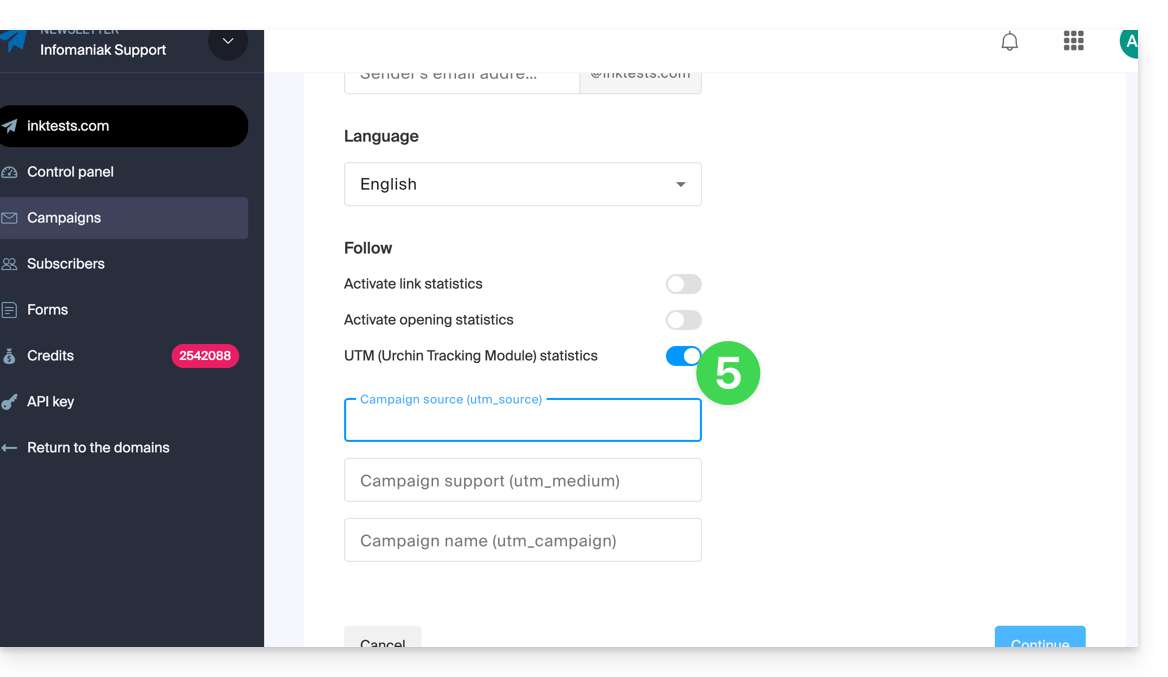
You will then find 3 fields to indicate keywords of type utm_parameters:
- campaign source (
utm_source) - campaign medium (
utm_mediumsuch as e-mail for example) - campaign name (
utm_campaign= the name of your campaign for example)
Therefore:
- Fill in the 3 UTM fields in step 1 of creating a Newsletter.
- Insert a link to the URL of your site (the latter must be properly configured and analyzed by Google Analytics for example) in the body of the Newsletter in step 3.
- When the reader clicks on it, they will arrive at the URL followed by the terms "
?utm_source=...&utm_medium=...&utm_campaign=..." with obviously your keywords in place of "...".
If you enter multiple keywords in these fields, any spaces will be replaced by underscore _ signs.
Later, it is planned to be able to enter dynamic formulas in these fields, such as today's date for example. Also, refer to the article https://news.infomaniak.com/comment-creer-un-objectif-google-analytics.
This guide presents the available conditions for segmenting and filtering your contact lists when sending an Infomaniak Newsletter.
Preamble
- Filtering subscribers based on certain criteria allows you to send Newsletters to specific people among your subscribers.
- The criteria can be their subscription date as well as custom fields or even actions performed or not during previous sends.
- You can combine multiple conditions and add "
OR" conditions to refine your filters.
Segmenting sends based on…
Access your Newsletter:
- Click here to access the management of your product on the Infomaniak Manager (need help?).
- Click on the domain name concerned in the table that appears:

… the specifics of the subscribers
Here is an example of a Newsletter subscription form with additional fields allowing you to request personalized information from the person signing up: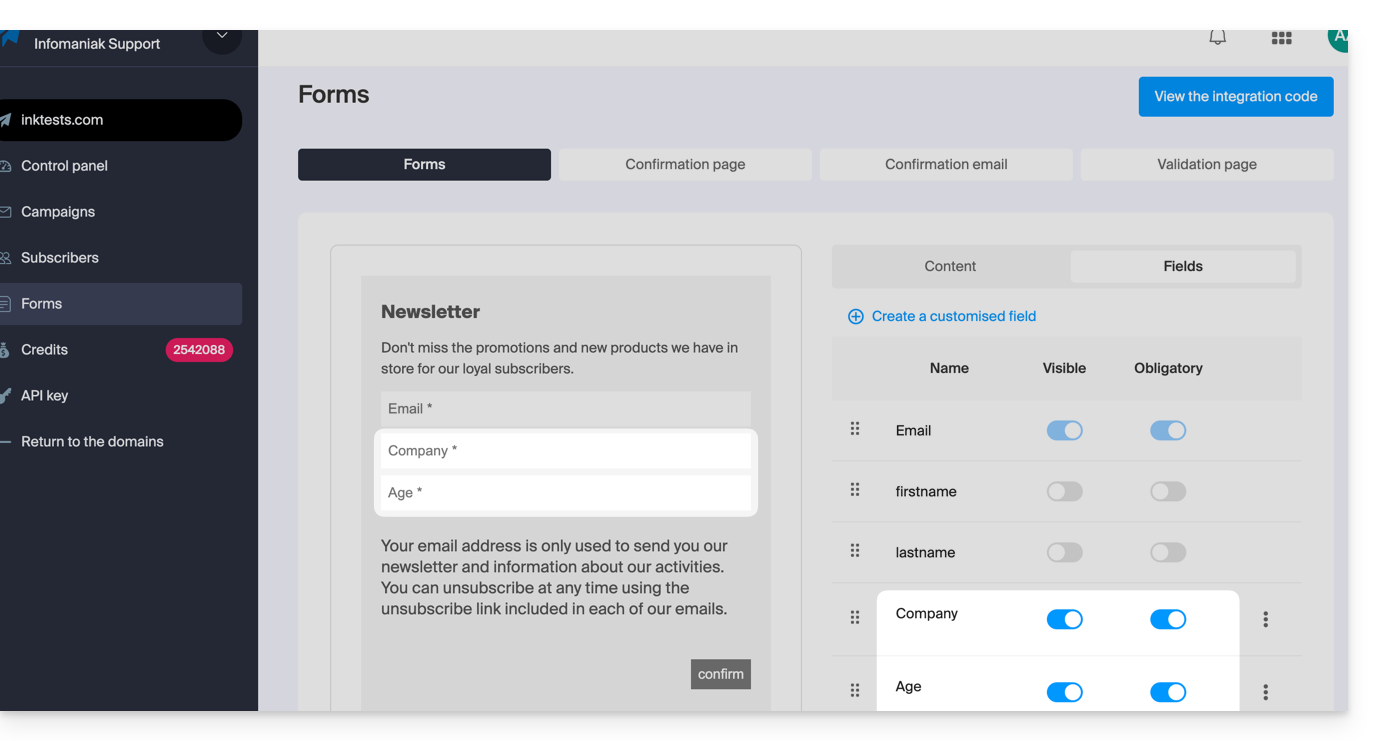
Once some users provide this information, you can find it in the details of their contact card: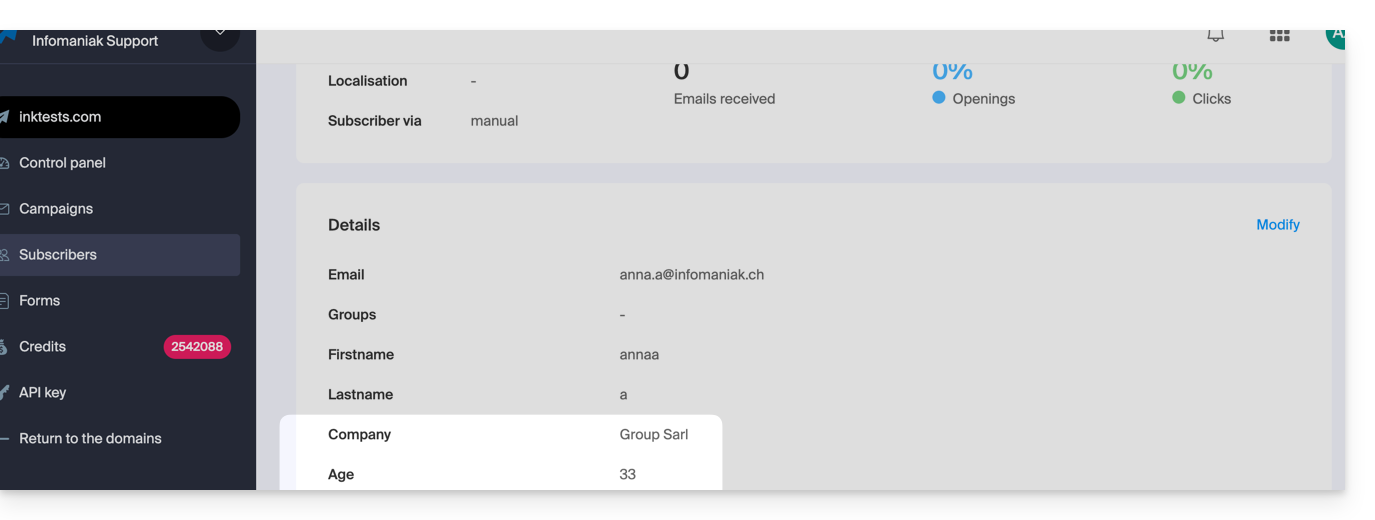
This type of information can be used to segment your subscriber list and only write to part of it. Refer to Chapter 4 of this other guide.
… the past actions of the subscriber
Information about a previous mailing can be used to segment your next send. Example:
- Send only to subscribers who have opened the last 5 campaigns.
- Send only to subscribers who have never clicked on the specific Newsletter sent 1 month ago.
- etc.
To do this:
- Refer to Chapter 4 of this other guide.
- Choose Actions instead of custom field to select the criteria defining the people who will receive this next newsletter.
- This same dropdown menu also allows you to segment a send based on the subscription dates of subscribers (e.g., send only to those who subscribed within the last month).
This guide explains how to create a token, or API key (or token) for the Infomaniak Newsletter tool.
Obtain a token
To obtain a Newsletter API key:
- Click here to access the management of your product on the Infomaniak Manager (need help?).
- Click directly on the domain name assigned to the product concerned.
- Click on API Key in the left sidebar menu.
- Click the blue button Generate a key:
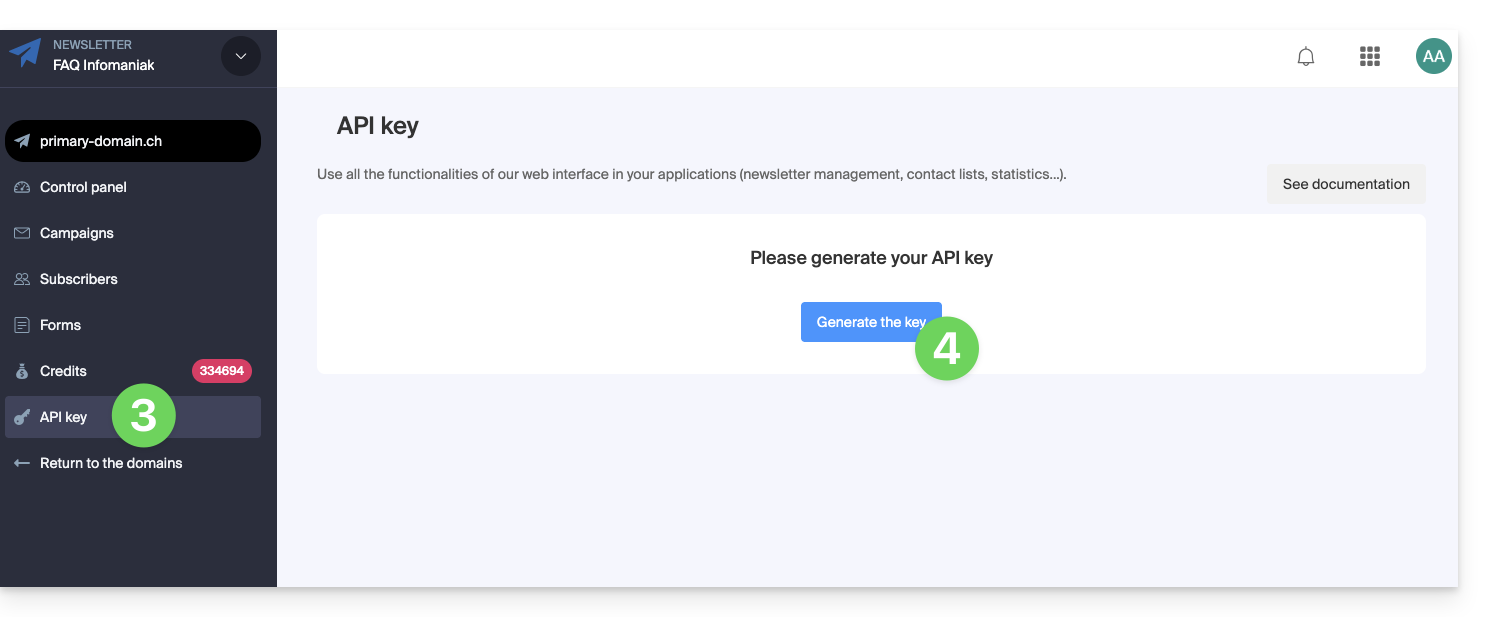
- Click the blue button Create a token:
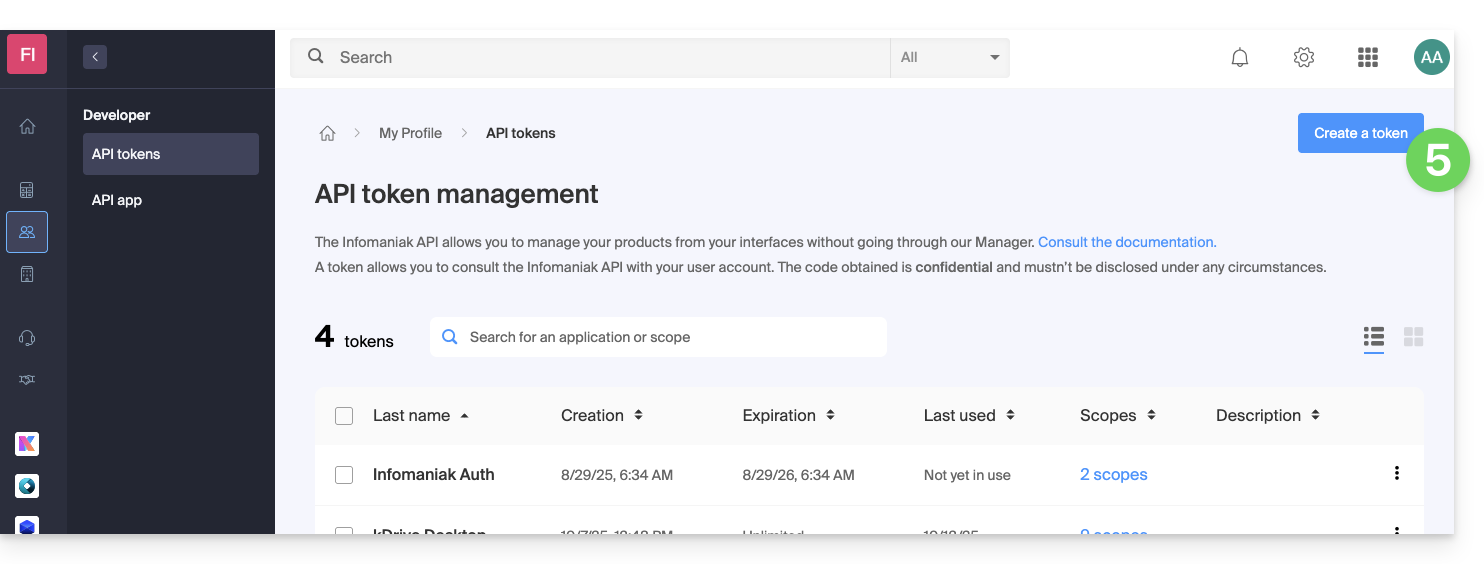
- Choose the appropriate product from the dropdown menu.
- Choose a validity period.
- Click the blue button Create a token:
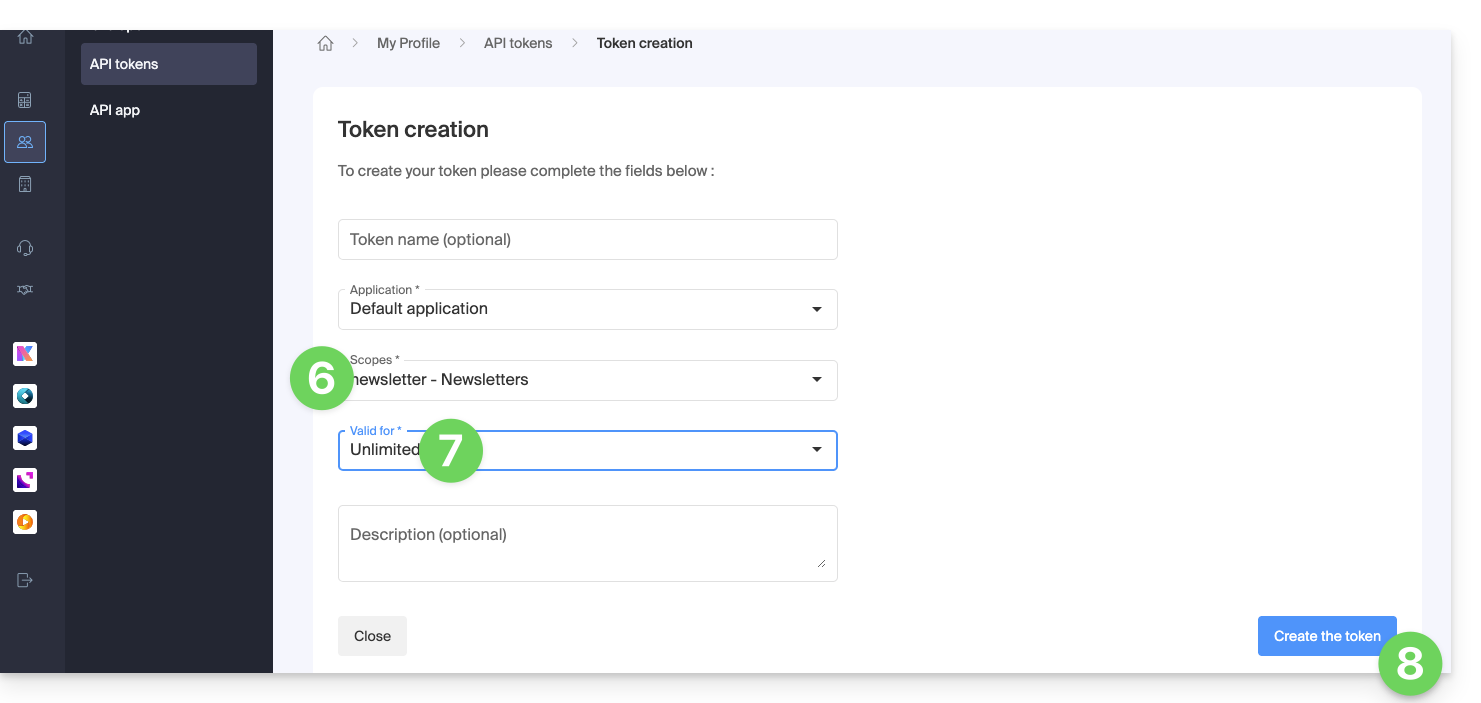
- Enter the password to log in to the Manager as requested.
- Copy the token to a safe place - it will no longer be accessible after that.
Refer to the Newsletter API documentation.
This guide details the rules to follow to send emails from Infomaniak to multiple recipients without it being considered as spam.
Preamble
- Infomaniak is a Swiss host governed by Swiss laws, federal laws (and general terms of use) which stipulate that before being added to an email mailing list, potential recipients must have given their consent.
Obtaining the recipient's consent
For a user's subscription to a newsletter to be considered voluntary, the latter must:
- Have entered their email address in a form dedicated to a specific subject.
- Have clicked on a validation link automatically sent after registration (point 1); this registration must only concern the subject specified at the time of registration.
- Be registered by the Newsletter system with their IP address and date.
This is called a double opt-in registration.
The term "double opt-in" refers to a registration process in which a user takes two distinct actions to confirm their intention to receive communications, usually newsletters or marketing emails.
The owner of an email address can at any time report any message received as spam. Collecting subscriber registrations by double opt-in is therefore the only way to protect against a potential spam complaint.
What to do in case of a spam complaint?
As an email provider, Infomaniak must demonstrate its cooperation in the fight against spam and ensure that all of its customers are not blocked/blacklisted by the email providers of potential complainants.
In the event of a spam complaint, Infomaniak can therefore temporarily suspend shipments and ask the sender of the message for proof of registration of the complaining person; if so, the complaint will become void.
On the other hand, the complaint will be justified if no proof of registration is provided and Infomaniak may be forced to take measures: suspension of the email address, domain name or termination of the contract in case of recurrence.
How to be compliant?
If you wish to carry out email campaigns, make sure you have the information from point 3 above (IP address and registration date of each subscriber). This process ensures that the user has explicitly confirmed their desire to receive communications, thus strengthening the legitimacy of the subscriber list and reducing the risk of spam or unauthorized sign-up.
It is therefore advisable to build your list by inserting a contact form on your website that will ensure the collection of your subscribers' email addresses via double opt-in.
An unsubscribe link must also be visible and appear at the bottom of each of your newsletters.
This guide explains how to use the Infomaniak Newsletter tool with an external domain name (not managed at Infomaniak).
Prerequisites
- The domain name must belong to you.
- Synonym domains and their main domain cannot be used to send newsletters.
- It is possible to configure your synonyms as aliases.
Link an external domain
To access the management of Newsletter sending domains:
- Click here to access the management of your product on the Infomaniak Manager (need help?).
- If you already have a Newsletter, click on Add a domain:
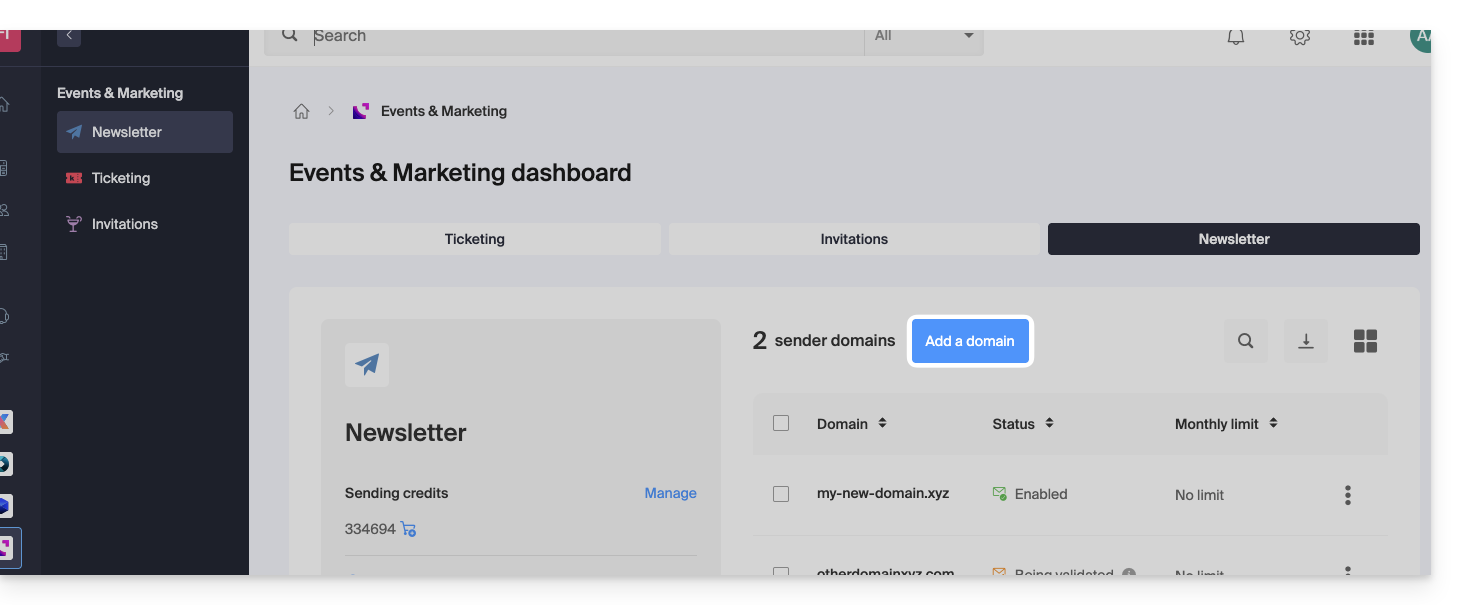
- Otherwise, click on Start for free:
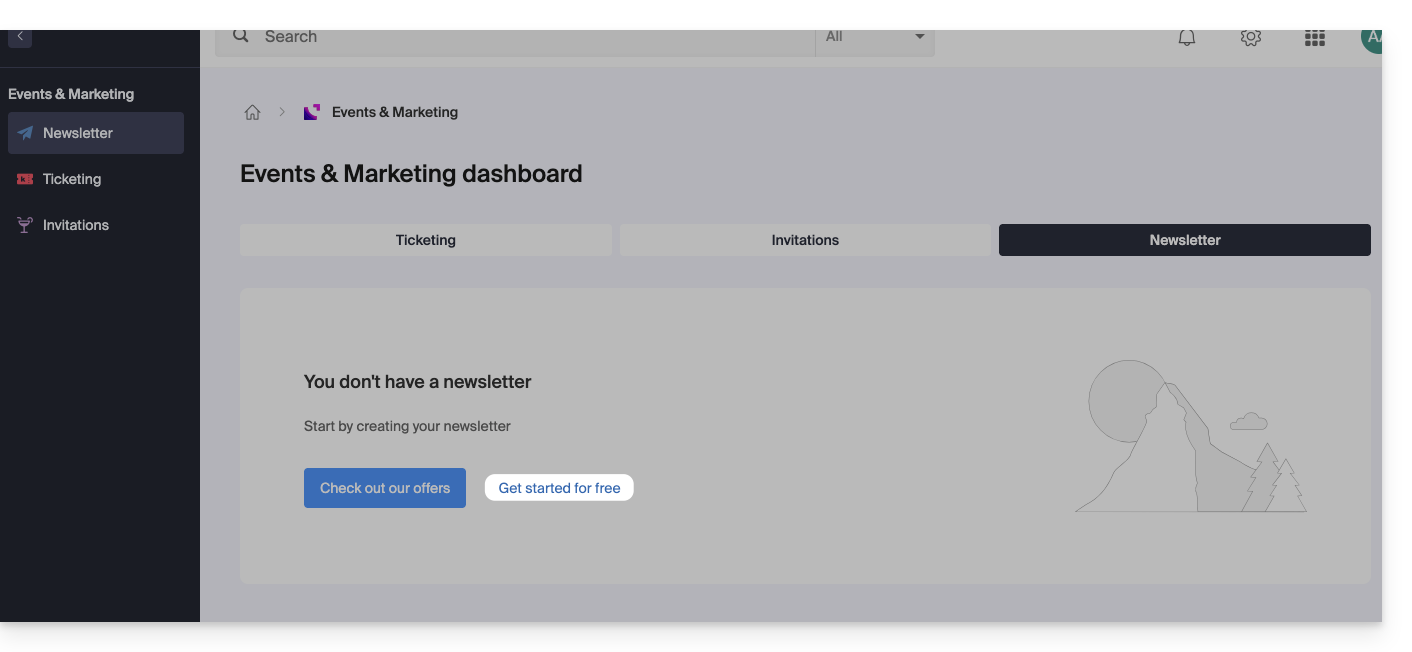
- Otherwise, click on Start for free:
- Select Other domain from the dropdown menu before entering (or enter directly) the domain name with which you want to send newsletters.
- Choose a possible monthly limit.
- Click the button to Continue:
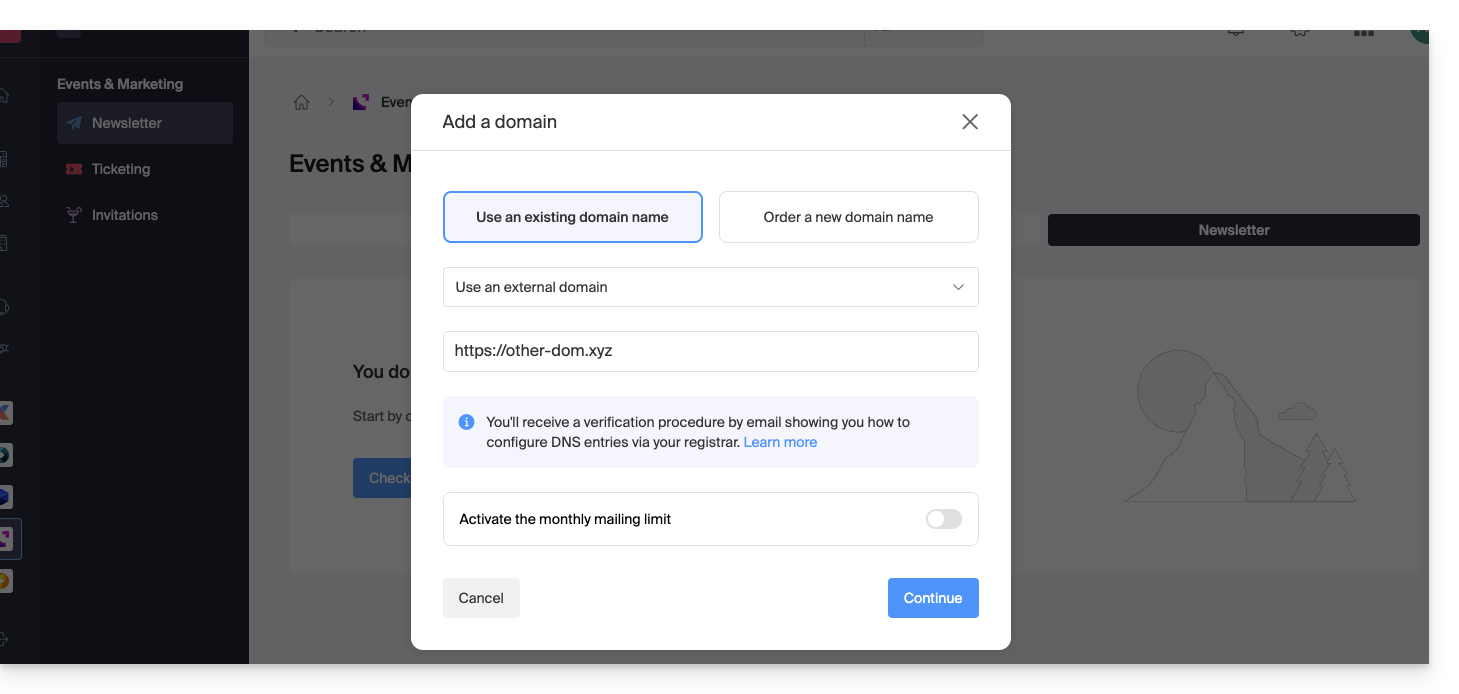
- Add the TXT / CNAME / DKIM records that you will receive by email and visible on the interface by clicking on the button:
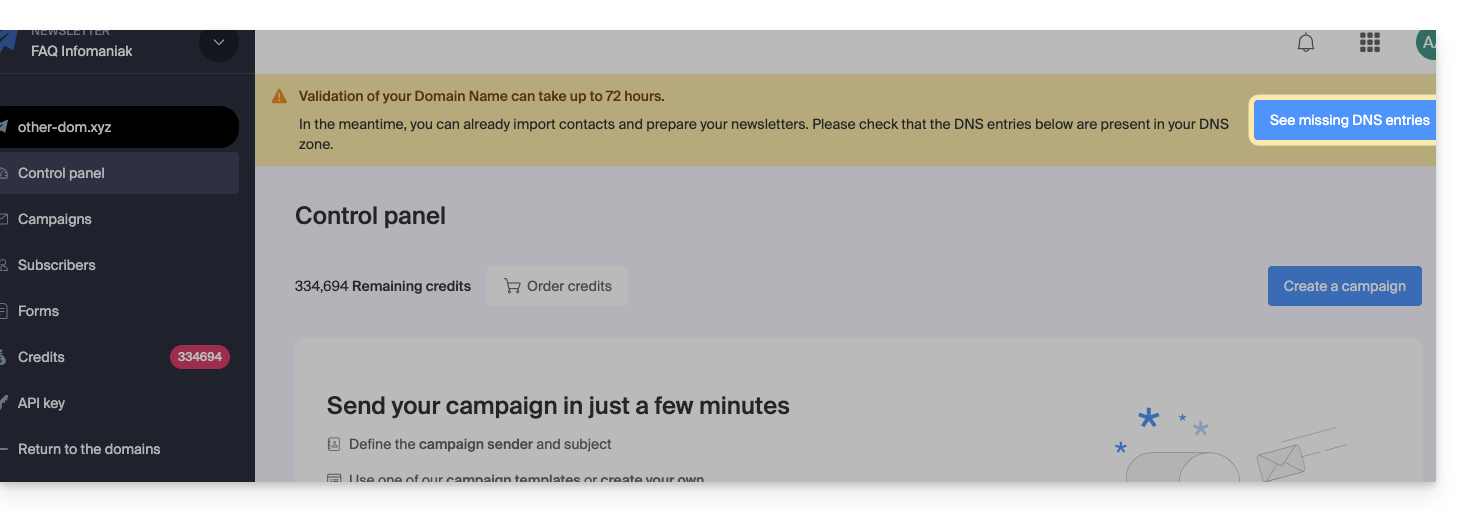
This guide explains how to manage Soft Bounce & Hard Bounce errors that can occur when sending emails, particularly when using the Infomaniak Newsletter.
Hard Bounce
A hard bounce is an email that cannot be delivered for permanent reasons.
- email sent to a false address
- domain of the recipient's email that is not a real domain
- recipient's server that does not accept emails
- etc.
Soft Bounce
A soft bounce is an error message indicating that the email is not delivered to its recipient and corresponds to a presumably temporary delivery problem: the email address is valid, the sender can resend the email.
Several reasons can explain a soft bounce and therefore why the recipient's server temporarily refuses the email:
- the recipient's inbox is full: due to insufficient storage capacity, the recipient no longer receives messages
- a problem occurs at the recipient's mail server: the server is temporarily unavailable or down, or the user has inadvertently set filters that prevent the reception of certain messages
- when the content of the email, particularly its attachments, is too large, the delivery problem is observed at the time of sending
Unless the recipient has permanently abandoned their inbox without deleting their account, the soft bounce is a temporary problem.
Example of the Infomaniak Newsletter tool after a send with a good score of 0% “Permanent Bounces” and 0.31% “Temporary Bounces”: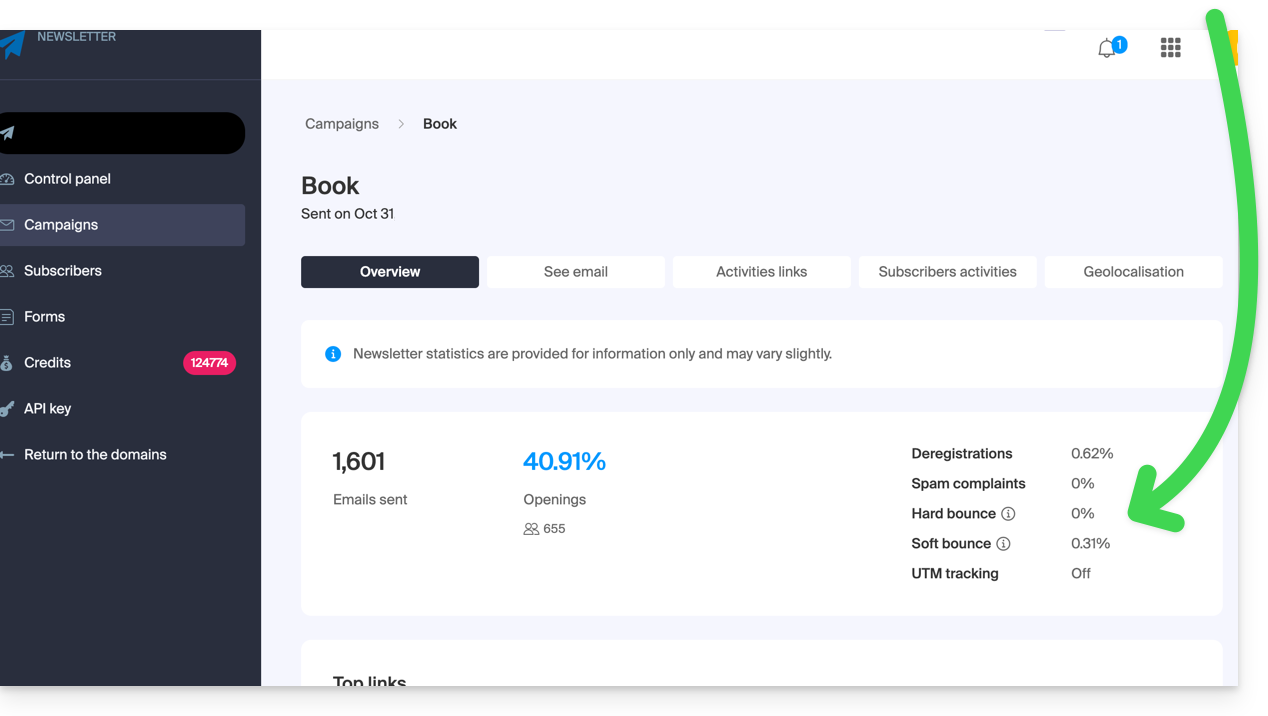
This guide explains how to freely integrate emojis / emoticons / smileys in the title and content of an Infomaniak Newsletter.
Insert an emoticon in the title
To choose an emoticon for your Newsletter title (and/or its preview text):
- Click here to access the management of your product on the Infomaniak Manager (need help?).
- Click on the domain name concerned in the displayed table:

- Click on Campaigns in the left sidebar menu.
- Click on Create a campaign:

- Click on the Smiley icon in the relevant field to open the emoji panel.
- Click on the emoji to insert:
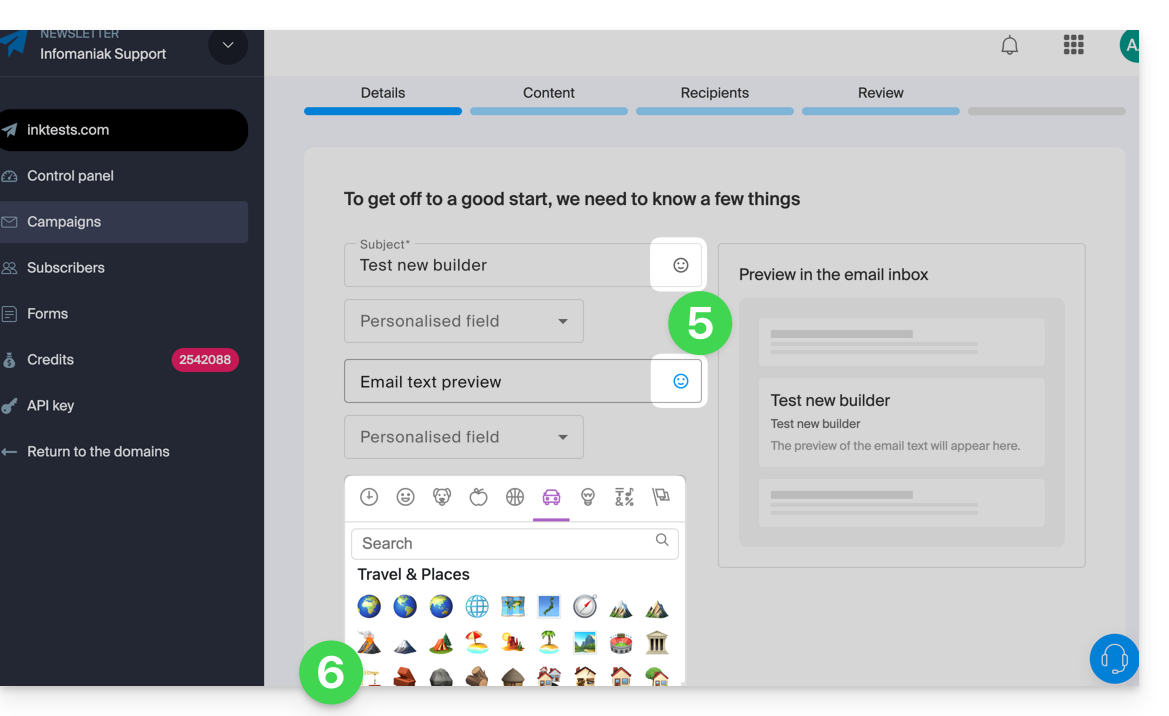
Insert an emoticon in the body of the email
You can paste any unicode character or emoji that you have copied elsewhere into your text: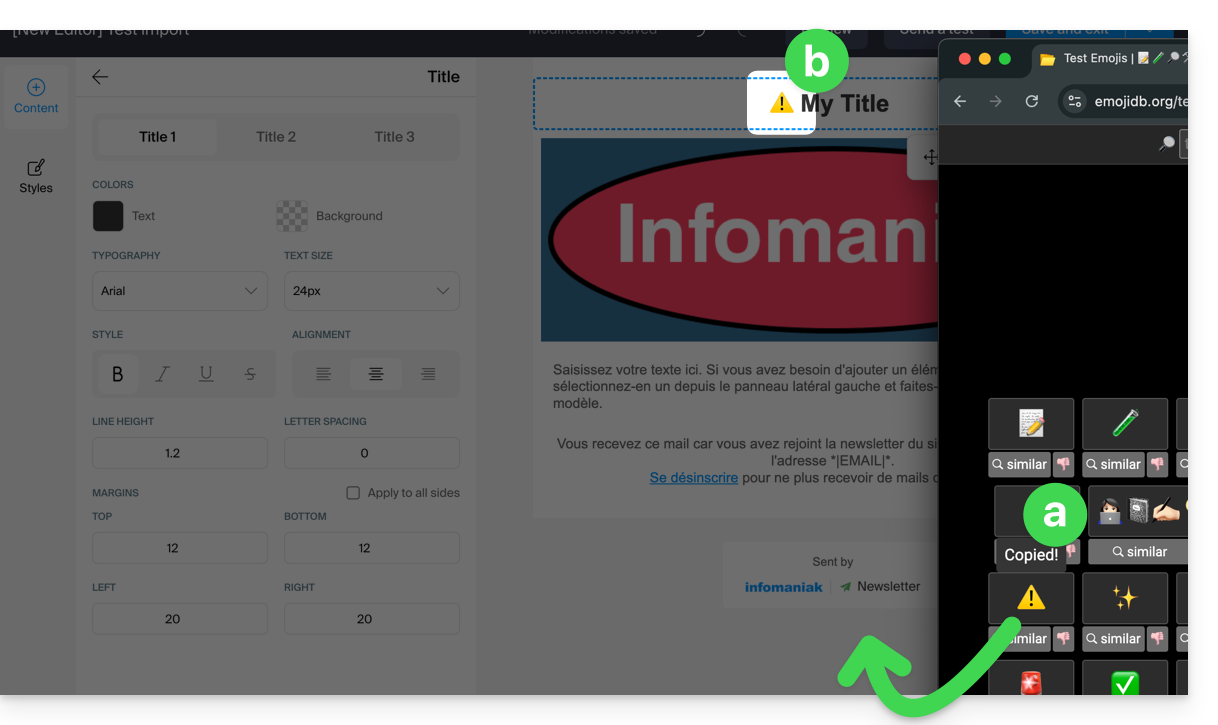
… or display emojis
… on macOS
Press the keys CTRL + CMD ⌘ + SPACE
… on Windows
Press the keys WINDOWS LOGO + PERIOD (.)
Alternative method:
- Right-click on an empty area of the taskbar.
- In the menu, click on Show the on-screen keyboard.
- A keyboard icon will then appear in the taskbar at the bottom right of your screen.
- Click on this icon to display the virtual keyboard.
- Click on the key with a smiley at the bottom left of the keyboard.
- Use the different Windows emojis.
This guide concerns Infomaniak authentication tokens or tokens, which are used to verify the identity of the application and grant it specific permissions to interact securely with the features and data of the Infomaniak API.
Preamble
- Authentication tokens or tokens are used to verify the identity of the application and grant it specific permissions to interact securely with the features and data of the Infomaniak API.
- There is no limit to the number of tokens you can create.
- The duration of an access token is "unlimited" by default, but it is possible to define a custom duration at its creation.
- Warning, if no call is made with the token for a year, it is automatically deactivated; it will then be necessary to generate a new one.
Manage Infomaniak API tokens
At the time of creating an API token, you will be able to choose the application and the scope accessible by the token (to match your current need and project).
To do this:
- Click here to access the management of your product on the Infomaniak Manager (need help?).
- Click the blue button Create a token.
- Choose from the drop-down menu the appropriate product according to your current need and project.
- Choose a validity period.
- Click the blue button Create a token.
- Enter the password to log in to the Manager as requested.
- Copy the token to a safe place - it will no longer be accessible after that.
Example of application: token for the Newsletter API

